Research Highlights 2016
Following the new conceptual framework outlined here, these Research Highlights are identified as contributing to understanding Earth Architecture (the roadmap for fluids) and/or Fluid Fluxes (the “traffic report”), with logos for easy attribution. For a full description of the Foundation Programs, see Appendix 1. and for the Flagship Programs see Appendix 2.

Genesis of deposits of scandium, a promising rare metal
Rare metals play a critical role in the future of our society, through their use in the energy transition and information and communication technologies. However, this future depends on the supply of these metals. Among them, scandium is particularly interesting for a large range of applications, from medicine to electronics. The main driver for scandium demand lies in the mechanical properties and lightness this metal can add to high-performance alloys, vital to reduce carbon emissions in the transport sector. However, scandium deposits are rare and their genesis is poorly understood. Recently, promising concentrations have been found in tropical soils from Eastern Australia. In a collaborative research project with researchers from the University Pierre and Marie Curie (Paris, France) and Jervois Mining Ltd (Cheltenham, Victoria, Australia), we have determined the scandium-bearing minerals in such deposits and the nature of their association with Sc at the atomic scale. The results give a better understanding of the mechanisms of their formation, a fundamental step for exploration and exploitation of these deposits.
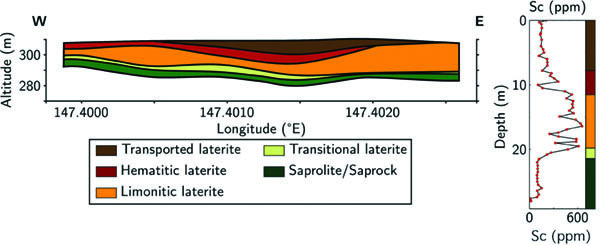
Figure 1. Diagram showing the different layers forming the lateritic cover of the deposit and evolution of the scandium concentration along these layers.
In Eastern Australia, volumes of ultramafic bedrock are frequently covered by a thick layer of residual rocks, called laterites. These formations developed during the Tertiary, under seasonally-dry humid tropical climatic conditions. These residual soils have been preserved by the geological stability of the Australian continent. Some areas are particularly enriched in scandium and constitute the richest deposits presently known for this metal. The samples studied come from the Syerston deposit, about 400 km west of Sydney. The wealth of this deposit provides a century-long resource for Sc at present levels of consumption.
The study of the parent rock, lying below the deposit, showed that it is already enriched in scandium compared to the Earth’s crust. This rock is mainly composed of clinopyroxene accumulated in subvolcanic feeder conduit. The enrichment in scandium is the result of the affinity of this element for clinopyroxene, in which it is concentrated during their precipitation. The scandium concentration strongly increases in the lateritic cover, reaching outstanding levels for this element in particular, in one layer: the limonitic laterite (Fig. 1). The mineralogical study of this layer showed the absence of scandium minerals. However, scandium is dispersed and correlated with the presence of iron oxides. These samples have been studied at the SOLEIL and ESRF synchrotrons in France using X-ray fluorescence mapping and X-ray absorption spectroscopy, confirming the close association between scandium and two particular iron oxides. Most of the scandium is adsorbed at the surface of goethite (FeOOH) while a minor part is incorporated into the crystal structure of hematite (Fe2O3) (Fig. 2).
This study has shown that the exceptional concentration of scandium in this deposit is the result of the initial fertility of the parent rock, and of its alteration in a tropical climate, leading to the release of Sc from the primary clinopyroxenes, and its trapping by newly formed iron oxides. Long time scales of alteration in the absence of major tectonic events explain the formation of this new type of scandium deposit. This development gives us the possibility to consider the development of new technologies based on the unusual properties of this metal.

This project is part of CCFS Theme 3, Earth Today, and contributes to understanding Fluid Fluxes.
Contacts: Mathieu Chassé, Bill Griffin, Sue O’Reilly
Funded by: CCFS Flagship Program 1

Figure 2. Proportion of scandium associated with the scandium-bearing mineral species in the deposit and diagram showing the nature of the association at the atomic scale. Scandium is adsorbed at the surface of goethite and incorporated into the crystal structure of hematite.
Oldest Evidence of life on Earth discovered
A Nature paper has documented the discovery of the oldest evidence of life on Earth in the form of stromatolites preserved in 3700 million-year-old carbonate rocks from Western Greenland.
The discovery was made by a team led by Prof Allen Nutman (U. Wollongong), Prof Vickie Bennett (ANU), Prof Martin Van Kranendonk (UNSW and CCFS) and others in a set of newly exposed rocks within a low-strain pocket of the famous Isua supracrustal belt. Previously, the area had been covered by permanent snow, but heavy spring rain uncovered the rocks. The new exposures revealed a series of bedded, though metamorphosed, dolomite and calc-silicate rocks that preserved primary sedimentary structures, including cross-stratification in calc-silicate rocks, units of storm-generated sedimentary breccias, and bedded carbonates with low-amplitude coniform and domical stromatolites (Fig. 1). The rocks form part of a stratigraphic succession - together with pillow basalt and banded iron-formation - that can be mapped around a fold structure.
Additional evidence in support of these structures being stromatolites and not either abiogenic primary structures or post-depositional structural features includes:
1. The composition of the rocks, which is dolomite, a mineral well known from other fossiliferous Archean sedimentary deposits. This contrasts with siderite or ankerite, Fe-bearing carbonates that are demonstrably metamorphic in origin. The dolomite has characteristic seawater-like REE+Y patterns and δ13C values (+1.2-1.5‰), characteristic of microbially-precipitated carbonate.
2. The geometry of the stromatolites, which clearly show upward growth from a flat (instigation) surface, and variable topographic morphology, as seen in other Precambrian, and living, examples. This precludes the structures being derived through boudinage, which produces symmetrical pinch-and-swell structures, or representing sedimentary flame structures, which have curved bases and show variation in sediment grain size.
3. Onlap of sediment onto the topographic highs of the stromatolites, indicating the structures formed on, and grew up above, the seafloor at the time of sediment accumulation.
4. The fact that a metamorphic foliation could be discerned that transected the bedding at a high angle, showing the bedding was a primary feature.
The sedimentary features and composition of the bedded dolomite and calc-silicate rocks suggest stromatolite growth in a shallow marine environment. This discovery pushes back the record of life on Earth by 220 million years, the equivalent to nearly half the length of the Phanerozoic. The significance is twofold. First, it shows that life on Earth began relatively early, soon after the end of the late heavy meteorite bombardment, which ceased at c. 3.9 Ga. Second, because the coniform morphology is characteristic of stromatolites formed by phototrophic organisms and occurs in a shallow marine setting, it suggests that life had evolved a complex metabolism (phototrophy) and was able to inhabit seawater by 3.7 million years ago. See CCFS publication #837, Nutman et al., Nature, 537, 535-538.

This project is part of CCFS Theme 1, Early Earth, and contributes to understanding Fluid Fluxes.
Contacts: Martin Van Kranendonk
Funded by: ARC Discovery Project
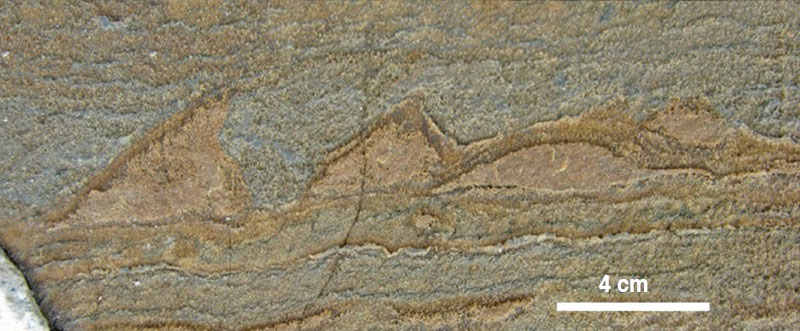
Figure 1. 3,700 million-year-old stromatolites from Western Greenland.
Does the mantle move beneath Northeast China?
Intraplate volcanism on continents is an exception to the general model of Plate Tectonics, which states that most of the world’s volcanoes both in oceans and on land occur at plate boundaries. Northeast China is an ideal place to study Cenozoic intraplate volcanism. Though located more than 2000 km west of the Japan trench, Northeast China hosts widely distributed Quaternary volcanism surrounding the Songliao Basin (SLB). Some of the most prominent volcanoes in the area include the well-known Changbaishan volcano in the southeast, the Jingpohu volcano in the east, the Wudalianchi volcano in the north, and two lesser known volcanoes, Abaga and Halaha, in the west (Fig. 1a). These Quaternary volcanoes are situated hundreds of kilometres apart with the SLB at the centre, which was formed by tectonic rifting in the late Mesozoic. Although it is generally agreed that the flat stagnation of the subducting Pacific slab in the Mantle Transition Zone has played an important role in the formation of Cenozoic volcanism in NE China, there is still little consensus about the mechanism responsible for the intraplate volcanism.
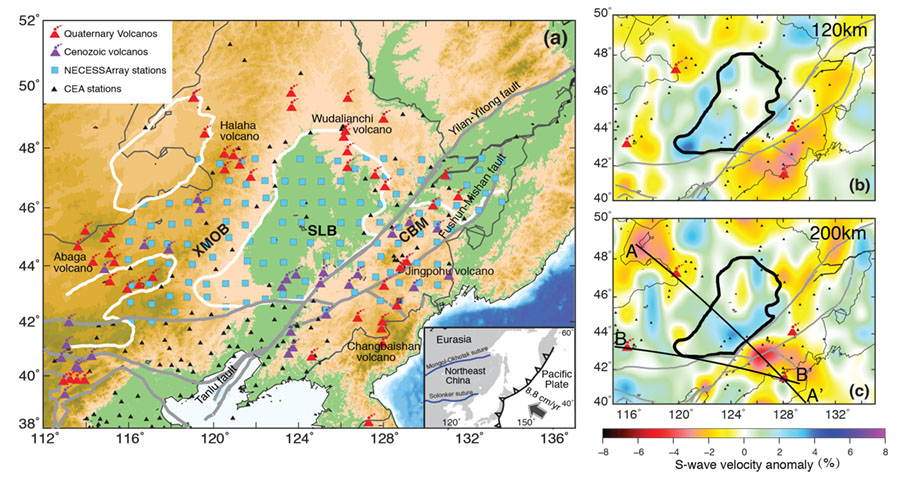
Figure 1. (a) Stations distribution and geological setting. Blue squares indicate 127 NECESSArray stations and black triangles denote 120 CEA stations. NE China is comprised of the Xing’an-Mongolia orogenic belt (XMOB), the Songliao basin (SLB) and the Changbai mountain region (CBM). Red and purple volcanic symbols are Quaternary and Cenozoic volcanoes in NE China. White lines outline major Mesozoic basins in NE China. CBV: Changbaishan volcano; JPHV: Jingpohu volcano; WDLCV: Wudalianchi volcano; HLHV: Halaha volcano; ABGV: Abaga volcano. NCC: North China Craton China, respectively. (b) and (c) S wave velocity anomaly from surface wave tomography at 120 and 200 km, respectively.
In order to understand the mantle processes responsible for the widespread magmatism in NE China, we constructed a high-resolution seismic model of the crust and upper mantle beneath NE China using seismic data recorded by the newly deployed NECESSArray. Our model reveals low-velocity anomalies in the upper mantle: one strong low-velocity anomaly beneath Changbaishan volcano in the east and relatively weak low-velocity anomalies beneath the Abaga and Halaha volcanos in the Xinmeng belt, surrounding a high-velocity anomaly beneath the SLB (Fig. 1 and 2). These low-velocity anomalies in the upper mantle are closely correlated with the distribution of young volcanic fields in NE China.
The widespread low velocity zone beneath Changbaishan has been interpreted as a large volume of upwelling hot asthenospheric materials that escape upward through a gap in the Pacific slab. The slowest velocity occurs at depths of 80-160 km (~-6% to -8%) (Figs. 2a and 2b), which may suggest the depths where partial melting mainly takes place, producing the magmas that feed the Changbaishan volcano. Cenozoic potassic basalts from the Changbaishan volcano and surrounding regions are interpreted to be derived by mixing of melts from the lithospheric mantle and the asthenosphere.
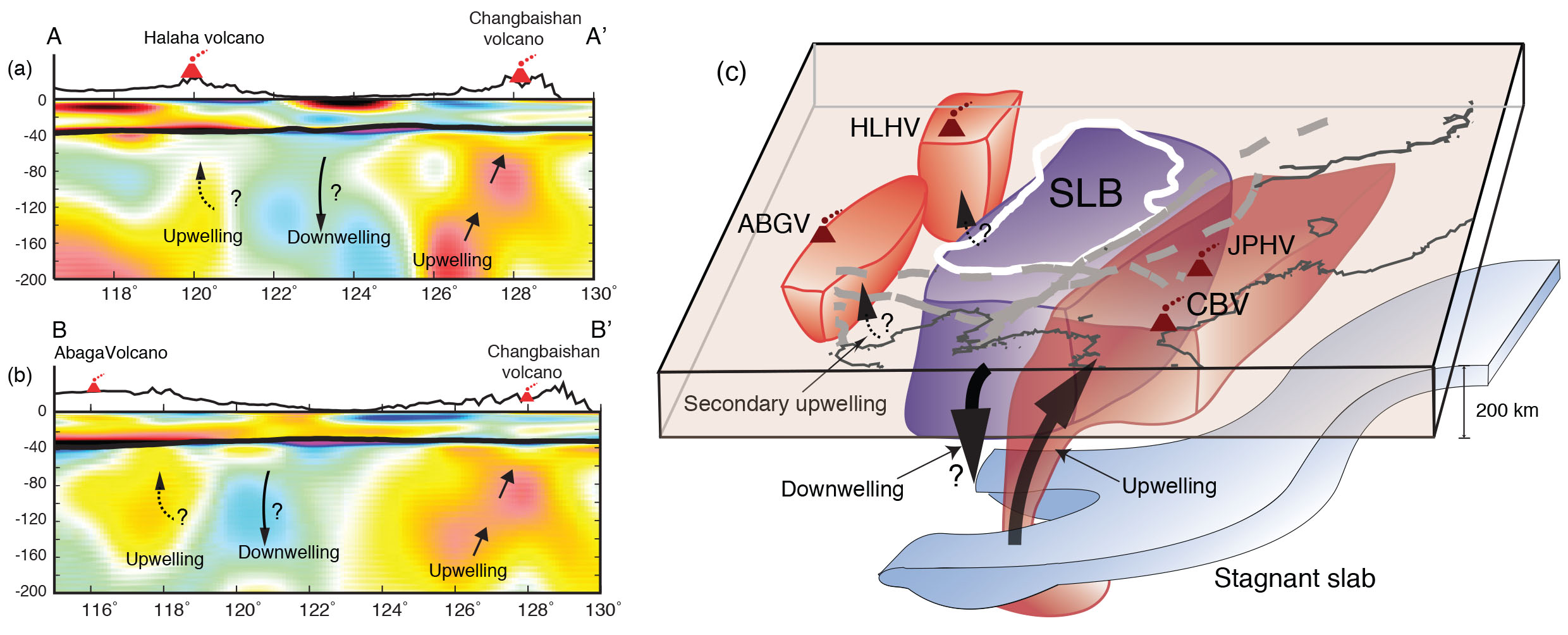
Figure 2. (a) and (b) Vertical cross-sections of S-wave velocities along A-A’ and B-B’. Locations of these profiles are shown in Figure 1c. Arrows illustrate the possible upper mantle upwelling/downwelling beneath NE China. Crustal thicknesses are denoted as black bold lines. (c) Schematic model for small-scale mantle convection in NE China.
The most intriguing feature is the high velocity anomaly in the uppermost mantle beneath the SLB, which extends at least to 200 km depth. The overlying crust of the SLB has undergone considerable extension during the late Mesozoic, and as a consequence, it seems unlikely to have preserved such a thick lithosphere. The S-wave receiver-function study also indicates that the lithospheric thickness beneath SLB is between 80 and 100 km. If the lithospheric thickness beneath SLB is about 100 km, then a question arises: what causes the uppermost mantle high velocity anomaly down to ~200 km beneath SLB?
Based on our results, we propose a sub-lithosphere mantle convection model to explain both the deep upper-mantle high velocities beneath the Songliao basin, and the volcanism in the Xinmeng belt. As illustrated in the 3D cartoon (Fig. 2c), a plume-like upwelling with a large volume of hot mantle material has ascended through the upper mantle beneath Changbaishan. This mantle upwelling may also feed magma to the Quaternary Jingpohu volcano, which is located east of the SLB. If this is the case, a mantle downwelling beneath the SLB could be induced by the mantle upwelling from the mantle transition zone beneath the Changbaishan. The high velocity beneath the SLB may thus correspond to a downwelling limb of a larger upper mantle convective system. The downwelling beneath the Songliao basin would further induce secondary local convection within the asthenosphere to the west, leading to local upwelling beneath the Abaga and Halaha volcanoes (Fig. 2c), which are also imaged here as mantle low-velocity zones, but weaker and shallower than the one beneath the Changbaishan volcano (Figs. 1 and 2).

This project is part of CCFS Theme 3, Earth Today, and contributes to understanding Earth’s Architecture and Fluid Fluxes.
Contacts: Zhen Guo, Yingjie Yang, Juan Carlos Afonso
Funded by: DP120102372, ARC Future Fellowship FT130101220, CCFS Flagship Program 3
Unveiling the early history of crust in Western Australia
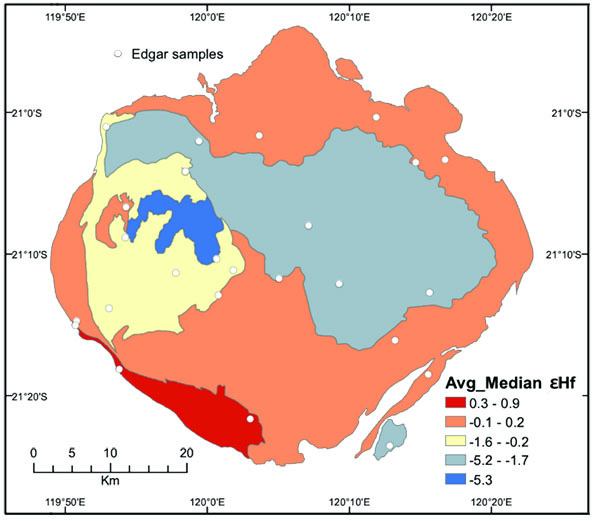
Figure 1. εHf isotopic map for the Mount Edgar Dome, East Pilbara Terrane, showing rim to core 3.5-2.8 Ga magmatism with increasingly evolved Hf signatures (From Gardiner et al. 2017, Precambrian Research, in review)
The Geological Survey of Western Australia (GSWA) in collaboration with CCFS and Curtin University has a major program for the acquisition and interpretation of Lu-Hf isotopic data, based on previously-dated zircon samples from GSWA’s extensive sample holdings. The research is focused in ‘greenfields’ areas where little information presently exists. More than 10,580 zircons, from 668 samples, have been analysed during the life of the project to date, including 56 samples and 1535 zircons in 2016. Zircon samples have been selected from dated material in igneous, metamorphic, and sedimentary rocks of the Pilbara Craton, the Eastern Goldfields Superterrane and Murchison Domain of the Yilgarn Craton, the Albany-Fraser Orogen, the Musgrave Province, sedimentary basins across Western Australia, the Rudall Province, the Gascoyne Complex, and basement rocks beneath the Eucla Basin. The project has addressed questions on the affinity of crustal blocks, helped map major lithospheric structures, and elucidated the timing of mantle input into the crust. The isotopic datasets produced have provided a powerful tool to understand fundamental components of mineral systems.

Figure 2. Gridded map of western part of the Capricorn Orogen in Western Australia showing the median Th/U ratio of magmatic zircon from U-Pb SHRIMP dated samples. Hot colours highlight areas dominated by juvenile rocks, whereas cool colours highlight magmatic rocks dominated by crustal reworking at the time of emplacement. The data highlight broad regions of crustal addition in the south and crustal differentiation and recycling in the central part (from Johnson et al., 2017; Lithos 268-271, 76-86).
Recent results of note include the first major Hf-isotope dataset from the East Pilbara, with a unique focus on the magmatic evolution of a single granite dome. The East Pilbara Terrane is the archetypal granite-greenstone belt, and studies of East Pilbara have informed many ideas regarding early Earth geodynamic processes. Hf isotopes, with their sensitivity to magmatic source, have the potential to add significantly to this debate. Using this Hf dataset, important interpretations regarding: (a) the geodynamic operating model of pre-3.2 Ga Earth, (b) the existence of a ca 3.7 Ga sialic protocrust in the East Pilbara, and (c) the change in geodynamic style post-3.2 Ga can be made. Specifically, results from the East Pilbara indicate that reworking of existing tonalite-trondhjemite-granodiorite (TTG) dominated late Paleoarchean magmatism, which supports a vertical tectonic geodynamic regime for the Pilbara prior to 3.2 Ga.
Other notable outputs in 2016 include a combined oxygen- and Hf-isotope study from the Capricorn Orogen of Western Australia. This data set was used to understand the process of cratonisation in which the in situ chemical differentiation of continental crust produced a stable crust. Zircon Hf and O isotopes in granites from this region reflect multi-component sources and shallow crustal processes associated with magma emplacement. An increase in the Th/U ratio of magmatic zircon tracks crustal differentiation in this orogen. Cratonisation processes in the Capricorn Orogen led to shallow parts of the crust, dominated by granitic rocks, with high Th/U magmatic zircons and elevated levels of heat producing elements, becoming more susceptible to reworking.
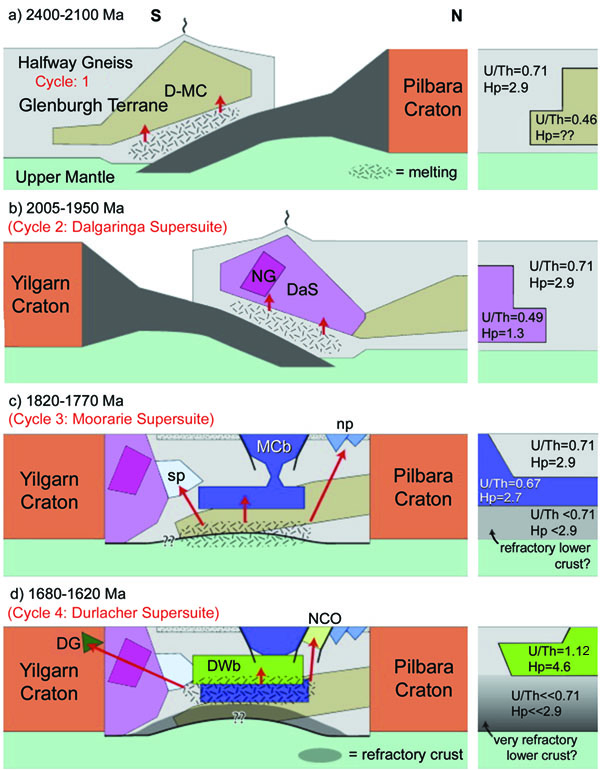
Figure 3. Schematic diagrams illustrating the tectonomagmatic evolution of the Capricorn Orogen as derived from the isotopic data. Panels on the right-hand side provide a summary of the median Th/U ratio of magmatic zircon as well as the present-day heat production (from Johnson et al., 2017; Lithos 268-271, 76-86).
New oxygen- and Hf-isotope data from sodic Sr-enriched magmas in the Rudall Province have proved important to understanding the crustal evolution and magmatic petrogenesis of this region. These magmas, although Proterozoic in age, are helpful to understand geochemically similar Archean magmatic rocks. Hf isotopes are sensitive to magmatic source compositions through time, and O isotopes are sensitive to the interaction of magmas with surface processes. The isotopic results from the Rudall magmatic rocks show that, despite the TTG-like compositions, some magmas have highly-evolved Hf-isotope compositions, implying that their source was not young subducting oceanic lithosphere. Furthermore, mantle-like O-isotope compositions in these rocks suggest negligible components from a near-surface environment. This magmatic process implies the thickening of mafic source regions to generate melt that formed the crust. Given the geochemical similarity of these specialised Proterozoic melts to Archean TTG rocks, this mafic thickening and extraction of felsic melts could be a viable method to generate early Earth crust.

This project is part of CCFS Themes 1 and 2, Early Earth and Earth Evolution, and contributes to understanding Earth’s Architecture and Fluid Fluxes.
Contacts: Chris Kirkland, Yongjun Lu, Michael Wingate, Nick Gardiner, Simon Johnston, Hugh Smithies, Elena Belousova, Ed Saunders, Rosanna Murphy, GSWA
Funded by: CCFS Flagship Program 7, GSWA
Mantle xenoliths from a young European extensional basin
The study of mantle rocks in young off-craton environments provides insights into the physico-chemical properties of the upper mantle during tectonic processes. The Pannonian Basin in Central Europe, located between the Alps, Carpathians and Dinarides, was geodynamically active throughout the Cenozoic. Its crustal structure and surface processes have been extensively studied, but we still have little knowledge about how the upper mantle there evolved.
Mantle xenoliths occur in five areas within the Carpathian-Pannonian region, hosted by late Miocene-Pleistocene alkaline basalts. The focus area of this study, the Nógrád-Gömör Volcanic Field (NGVF) is located in the northern margin of the Pannonian Basin (Fig. 1). The host basalt at this locality is calculated to have reached the surface in ~36 hours, so the entrained xenoliths are considered to closely reflect the conditions in the upper mantle beneath the area. Thus they provide an excellent base for reconstructing geochemical processes.

Figure 1. Top left: Alkali basalt-hosted xenolith occurrences in the Carpathian-Pannonian region. Right: Distribution of basalt outcrops and sampling localities in the NGVF. Bottom left: samples from the lherzolitic and wehrlitic series.
Two major rock series have been identified among the NGVF xenoliths: lherzolitic and wehrlitic (Fig. 1). The lherzolitic group, which is the focus of this research, has a wide range of geochemical compositions; four subgroups were distinguished based on the Mg# of olivine and LREE/HREE ratios in pyroxenes. Each of these subgroups records a different metasomatic process or processes, which overprint the chemical signature of an ancient melt extraction event with removal of between 5 and 30% melt. Modal metasomatism is reflected by the presence of amphiboles, which have trace element contents matching those of clinopyroxenes in each xenolith where they appear (Fig. 2a). Thus two types have been distinguished, a Nb-poor type with a suprasubduction origin, and a Nb-rich type (Fig. 2b) which is inferred to have formed as mafic melts percolated through the upper mantle prior to the eruption of the host basalt. Such melts were responsible for causing enrichment in LILE-LREE to different extents in a group of the lherzolitic xenoliths, and a further addition of Fe, Mn and Ti in another. This latter group represents a transition towards the wehrlitic series, which is characterised by the lack of modal orthopyroxene, and contains secondary clinopyroxene, exhibiting Fe-Mn-Ti-LREE enrichment.
Equilibrium temperatures have been calculated with different thermometers, and a discrepancy of ~50-100°C was found between values obtained by major-element based and REE-based methods (Fig. 2c, d). Since trivalent REEs have higher closing temperatures than the divalent major elements used by conventional thermometers, this difference can be explained by a major thermal event in the recent history of the NGVF mantle. It is assumed that the higher temperatures from REE-based thermometers reflect the heating by the extension and asthenospheric upwelling in the Pannonian Basin, whereas lower temperature values represent thermal relaxation and cooling following extension.
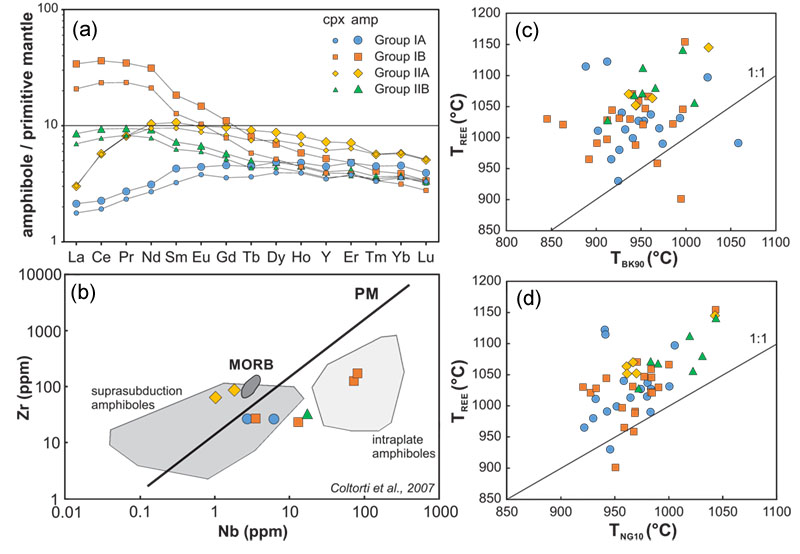
Figure 2. a) REE-distribution of clinopyroxenes and coexisting amphiboles. b) Nb-content based distinction of amphiboles from different environments. c-d) comparison of equilibrium temperatures calculated with REE- based (TREE) and major element based thermometers (TBK90 = two-pyroxene method of Brey & Köhler, 1990; TNG10 = Ca-in-opx method of Nimis & Grütter, 2010).
The distribution of textural types and crystal-preferred-orientation data acquired by EBSD (electron backscatter diffraction) analysis, as well as calculation of seismic properties, reveal that the three major domains of the NGVF (northern, central and southern) experienced different degrees of deformation. Xenoliths from the southern part represent a low-temperature, more equilibrated, fine-grained mantle domain, whereas the northern part is dominated by coarse-grained, high-temperature material with significant intragranular deformation. The strength of deformation and seismic anisotropy is highest in the central part, and is suspected to reflect a tectonic boundary beneath the area.

This project is part of CCFS Theme 2, Earth’s Evolution, and contributes to understanding Earth’s Architecture and Fluid Fluxes.
Contacts: Nora Liptai, Sue O’Reilly, Bill Griffin, Norm Pearson, Csaba Szabó, Levente Patkó (Eötvös University, Budapest, Hungary)
Funded by: Flagship Program 1, iMQRES, EPS postgraduate funds, Eötvös University postgraduate scholarship. This research is part of a cotutelle project between Macquarie and Eötvös University (Budapest, Hungary)
Apatite - tracer for the evolution of porphyry systems
Analysis of the evolution of porphyry systems is key to better understanding how, when, and why fertile (i.e. metal-rich) igneous-hydrothermal systems develop. Accessory minerals, and in particular apatite, can serve as archives for the evolution of such systems. Apatite is ubiquitous in granitic rocks and can potentially record fluid evolution to lower temperatures (i.e. later stages) than zircon. Apatite hosts a range of trace elements, which can be used to establish the physical-chemical conditions of the magmatic system. Of particular interest are the REE, the halogen group elements (Cl, F, Br) and S, which provide constraints on the system’s oxidation state, fluid source and metal transport capabilities. Previous studies have claimed that certain trace elements can be used to distinguish between fertile (i.e. ore-forming) and barren (ore-absent) porphyry systems. However, the proposed discrimination factors, based on trace element concentrations and ratios, are not universally applicable. In this study we will investigate porphyry systems of the Macquarie Arc (NSW) where several pulses of barren and fertile magmatism have been recognised. This igneous activity is spatially and geochronologically well-constrained, so the Macquarie Arc porphyries are an ideal case-study site. The geochemistry of apatite will be combined with whole-rock data, which include the REE and isotopic tracers such as Sm-Nd. Whole-rock analyses and in situ mineral geochemistry of apatite will then be used to address the following fundamental questions:
• How representative is the geochemistry of apatite of its host rock?
• Can apatite be used to identify fertile igneous (porphyry) systems?
• Can metamorphic and igneous apatite be distinguished?
Solving the last question will be essential if apatite separates, such as detrital concentrates, are to be used to trace igneous systems in the prospective regions.
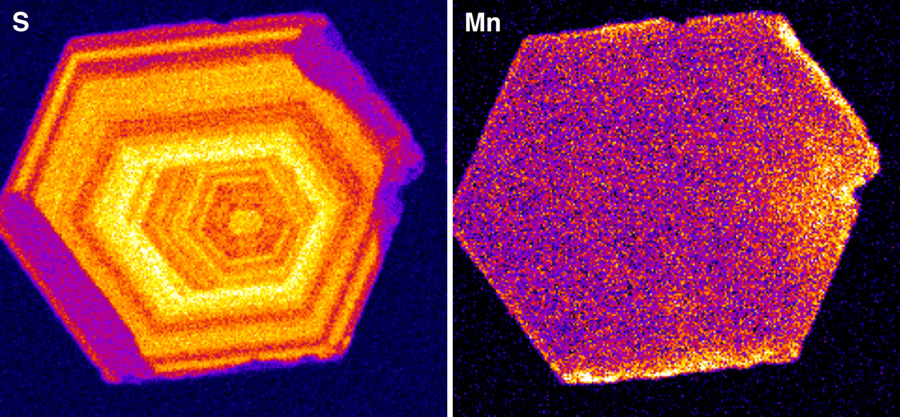
Quantitative EMPA maps of S and Mn in apatite from a mineralised porphyry system.
Preliminary results of quantitative EPMA element mapping (Fig. 1) show that apatite from mineralised systems often is distinctly zoned in terms of S concentrations, which is not observed in apatite from barren systems. This observation might give a first indication about the importance of S as a ligand for metals and related metal-melt-unmixing processes, which may be a key to mineralisation. In order to understand the source of S, we are currently developing a method to measure S isotopes in situ in apatite by SIMS. Sulfur-isotope ratios from apatite can then be coupled with Sm-Nd and other tracers to gain detailed insights into the geochemical evolution of porphyry systems.
This project is part of CCFS Themes 2 and 3, Earth Evolution and Earth Today, and contributes to understanding Fluid Fluxes.

Contacts: Johannes Hammerli, Tony Kemp, Phillip Blevin, Marco Fiorentini
Funded by: CCFS Flagship Program 2
Hafnium isotopes record supercontinent cycles
We interrogated a large global Hf isotope dataset (>40,000 points), using a new statistical approach to track the most juvenile part of this dataset through time, linking secular variations with the supercontinent cycle.
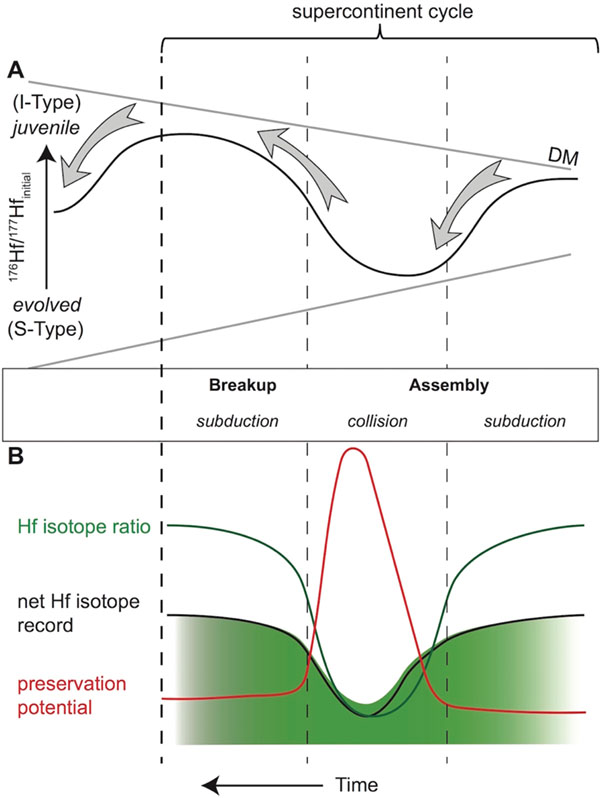
Figure 1. A. Schematic showing the conceptual evolution of initial 176Hf/177Hf ratios with respect to the stages of supercontinent assembly and breakup.B. Diagram showing the proposed effect of preservation bias on the Hf signal during a supercontinent cycle. Preservation curve and volume of generated magma retained in the geological record, and a lack of preservation will dilute global juvenile Hf signals towards a less radiogenic baseline, but will not affect the more evolved part of the record during continent collision. The net effect is to dampen but not remove the Hf isotope signal. The depth of shading reflects intensity of signal, based on number of analysis.
We statistically correlated supercontinent amalgamation intervals with episodes of evolved Hf, and breakup leading to re-assembly with episodes of juvenile Hf. Further, we found that the juvenile Hf signal is more sensitive to Pangaea and Rodinia assembly, its amplitude increasing with successive cycles to a maximum with Gondwana assembly, which may reflect enhanced subduction-erosion. We demonstrated that the juvenile Hf signal carries important information on prevailing global magmatic style, and thus tectonic processes.

This project is part of CCFS Theme 2, Earth’s Evolution, and contributes to understanding Earth’s Architecture and Fluid Fluxes.
Contacts: Nick Gardiner, Chris Kirkland, Martin Van Kranendonk
Funded by: CET-Curtin internal funding
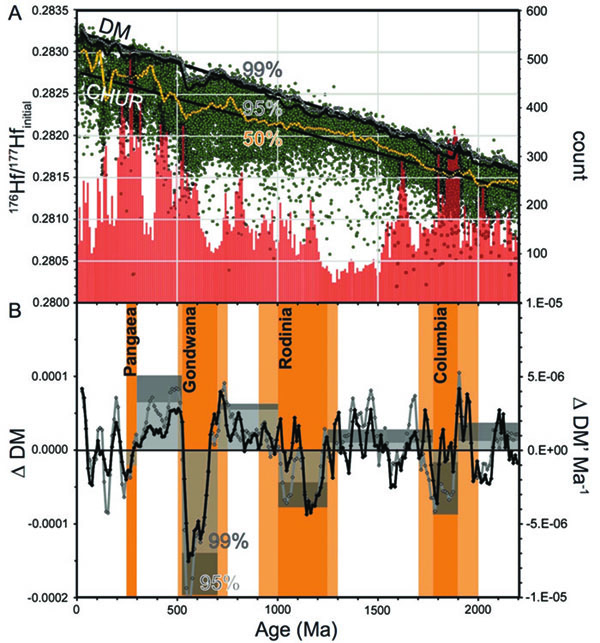
Figure 2. A. Global Hf dataset: initial 176Hf/177Hf versus U-Pb magmatic age from 0 to 2200 Ma. The 99th, 95% and median (50%) moving average time series are plotted. B. ΔDM (left scale) - a de-trended difference between DM and the Hf signal per 10 Ma; black = ΔDM95; grey = ΔDM99. A histogram of the ΔDM99 and ΔDM95 signals, the time-integrated difference for the periods within and between the indicated supercontinent assemblies (right scale). Periods of supercontinent assembly shown, with timeline A in dark orange and timeline B in lighter orange. Both from Gardiner et al. (2016), Scientific Reports 6, 38503 (CCFS publication #874).
Strange mineral companions
Moissanite (SiC) is a rare mineral in terrestrial rocks. It can only form in environments with extremely low oxygen fugacity (ƒO2) [at least 6-8 log units below the Iron-Wüstite (IW) buffer], which are not consistent with the normal ƒO2 conditions (above IW) of the Earth’s lithosphere. The occurrence of SiC and other very-reduced phases (e.g. native metal) in mantle rocks of the Tibetan ophiolites (e.g. Luobusa) has caused great concern about their formation and preservation mechanism in the Neo-Tethyan oceanic lithosphere. We report new observations of intergrown grains of SiC and associated oxidised phases from the Zedang ophiolite (close to the Luobusa ophiolite) in the Yarlung-Zangbo Suture Zone (South Tibet, China), and suggest a rapid dynamic process to isolate the host lithospheric fragment from ambient mantle.

Figure 1. Back- scattered electron (BSE) images of a representative SiC grain (a) and its enclosed Si and Fe-Ni alloy (b), separated from harzburgite from the Zedang ophiolite (South Tibet).
SiC grains with diameters of ~100-500 μm have been separated from the Zedang harzburgite, chromitite and pyroxenite, all collected from the refractory harzburgite domain defined by Xiong et al. (2016 EPSL, 438, 57-65, CCFS publication # 691). Combined imaging (optical microscopy and scanning electronic microscropy) and qualitative analyses (energy dispersive spectroscopy and laser Raman spectroscopy) have revealed that the SiC grains (mainly 6H polytype) contain droplet-shaped inclusions of Si metal and unmixing Fe-Ni-V-Ti-Mn-Si alloy (Fig. 1), suggesting formation at very high temperatures (≥~1400-1500 ºC) and ultra-reduced conditions (ƒO2≤IW-6). Interestingly, some SiC grains are irregularly surrounded by K-rich silicate glasses, which contain inclusions of crystalline zircon. One SiC grain shows gradual oxidation from SiC, through Si and Si-C-O mixtures, to amorphous SiO2, recording a complex reaction texture suggesting quenched glasses surrounding crystallised SiC (Fig. 2).
The coexistence of SiC and oxidised glasses, as well as the quenched texture, suggest that there must be a dynamic process (i.e. quenching) rapid enough to seal the extremely un-equilibrated phases and textures. Thermodynamic simulation of diffusive equilibration of SiC in an olivine matrix (Mg#=90) suggests that a SiC grain with a diameter of 300 μm will need ~1-10 million years to be consumed under temperatures of ~600-700 ºC (Schmidt et al., 2014, PEPS, 1:27, 1-14). These temperatures are consistent with those calculated from olivine-spinel pairs in the Zedang peridotites and chromitites. Therefore, to preserve these SiC grains and associated oxidised phases would require a rapid cooling process from peridotite solidus temperatures to ~600-700 °C, within several million years. This process may reflect the very rapid ascent of the recycled peridotites and chromitites (host for the super-reduced phases) from the Mantle Transition Zone or deep upper mantle to lithospheric levels (Griffin et al. 2016, J.Petrol. 57, 655-684. CCFS publication #704) This rapid exhumation process has suppressed the thermodynamic consumption of SiC and other super-reduced phases with the host peridotites and chromitites, and eventually preserved them in the Neo-Tethyan oceanic lithosphere.
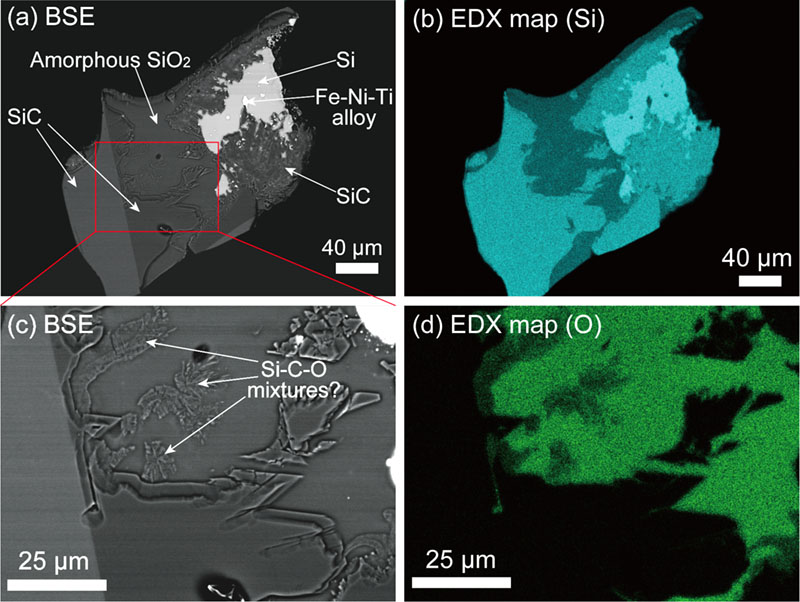
Figure 2. Back-scattered electron (BSE) images (a, c) and energy-dispersive X-ray (EDX) maps (b, Si; d, O) of a complex intergrowth grain of SiC with Si + Fe-Ni alloy (primary stage), reacted with oxygen-rich fluids/melts that formed amorphous SiO2 and newly crystallised unknown Si-C-O mixtures (secondary products).

This project is part of CCFS Theme 2, Earth Evolution, and contributes to understanding Earth’s Architecture and Fluid Fluxes.
Contacts: Qing Xiong, Bill Griffin, Jian-Ping Zheng (CUG Wuhan), Jin-Xiang Huang, Sarah Gain, Norman Pearson, Sue O’Reilly
Funded by: CCFS Flagship Program 1, NSFC
An Archean microcontinent lurking in the Capricorn Orogen
The Capricorn Orogen (Fig. 1a) formed during the Paleoproterozoic amalgamation of the Archean Pilbara and Yilgarn cratons to form the Western Australian Craton. Regional surveys involving geological mapping, geochemistry, and geophysics reveal a prolonged tectonic history of craton assembly and subsequent intracratonic reworking, which have significantly re-shaped the orogenic crust.
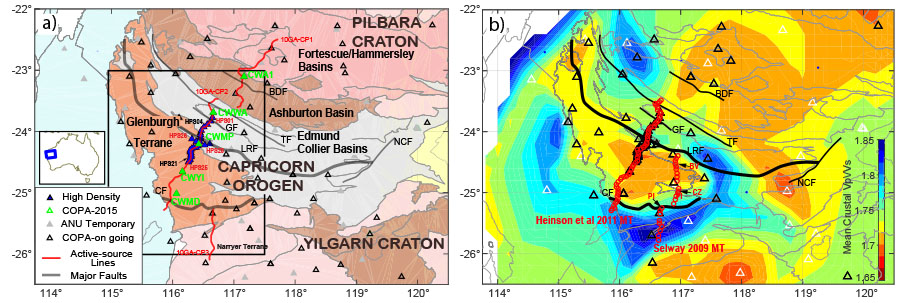
Figure 1. Crustal elements and seismic stations in the Capricorn region (a). The crustal element boundaries are simplified from the Geological map of Western Australia (2015). Red lines are the active source lines conducted by Geoscience Australia in 2010. The black and green (used in this study) triangles show the on-going Capricorn Orogen Passive-source Array (COPA). The High-density Passive Source (HPS) array is shown as the red triangles, which is partially collocated with active source line 10GA-CP2 (the middle one). Labels in a) are major faults: BDF Baring Downs Fault; TF, Talga Fault; GF, Godfrey Fault; LRF, Lyons River Fault systems; CF, Cardilya Fault; and NCF, Neds Creek Fault. (b) The seismic Vp/Vs ratio measurements which is indicative of an overall felsic composition of the Glenburgh Terrane bounded by major faults.
Using data from the on-going Capricorn Orogen Passive-source Array (COPA) stations and a high-density linear array embedded among the COPA stations (Fig. 1a), we conducted seismic receiver function and ambient noise studies targeting the Glenburgh Terrane, an exotic late-Archean to Paleoproterozoic crustal block previously inferred from distinct structural and isotopic characters in the core region of the terrane. The prominent Moho and intracrustal discontinuities vary across the terrane boundary, showing a relatively thin crust (<40 km) with small Vp/Vs ratios (~1.70) in the Glenburgh terrane, compared with the thickened (>40 km) crust with elevated Vp/Vs ratios (>1.76) near the margins. Low Vp/Vs ratios (~1.70) are mapped terrane-wide (Fig. 1b), similar to what we have observed in the Archean Pilbara and Yilgarn cratons; they indicate a felsic bulk composition for the crust. Considering the available isotopic age data, and constraints from magnetotelluric and absolute shear wave velocity data (Fig. 2), the Glenburgh Terrane is interpreted as a microcontinent made in the Archean. A fast velocity is observed in the shallow crust (intraplating; Fig. 2), which suggests the crust was reworked during the assembly and cratonisation of the WAC and the subsequent intracratonic reworking/magmatic differentiation processes.
Our results illustrate that multi-disciplinary datasets bring complementary resolution and therefore may put tighter constraints on the tectonic processes that have affected the crust. See CCFS Publication #649, Yuan, 2015, Nature Geoscience 8, 808-103; Yuan et al., 2017, Crustal structure of the Glenburgh Terrane: the role of a microcontinent in the Paleoproterozoic craton assembly in Western Australia, submitted to JGR.
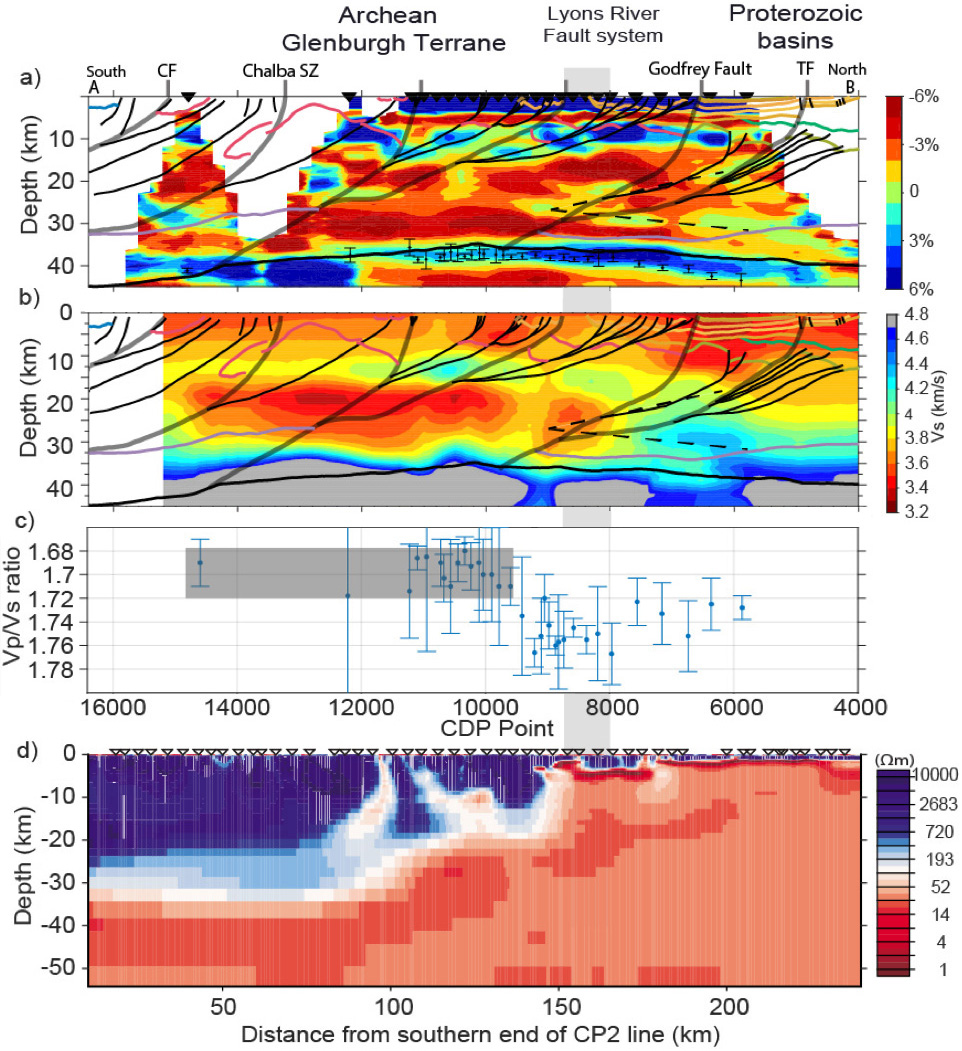
Figure 2. A compilation of available geophysical observations for the high density array, following the 10GA-CP2 line. a) Receiver function common-conversion-point stacking imaging showing the velocity gradient beneath the array. The active source interpretations are overprinted as lines. The vertical grey line shows the boundary of the Glenburgh Terrane and the Proterozoic basins. b) The shear- wave velocity model from the ambient noise inversion. Note the fast velocity shallow crustal layer which is also indicated in the receiver functions as a positive velocity gradient. c) The Vp/Vs ratio measurements. The small Vp/Vs ratios marked by the shaded region within the Glenburgh Terrane suggest a felsic bulk crustal composition, similar to that in the Archean Pilbara and Yilgarn and other global cratons. d) the 2010 magnetotelluric modeling image, showing the Glenburgh Terrane is resistive in shallow to middle crust, a common feature observed in Archean crust.

This project is part of CCFS Themes 1, 2 and 3, Early Earth, Earth’s Evolution and Earth Today, and contributes to understanding Earth’s Architecture.
Contacts: Huaiyu Yuan
Funded by: CCFS Flagship Program 7, SIEF Capricorn distal footprint
Magmatism lights up northern Gondwana 500-600 million years ago
Magmatism in continental arcs is often episodic, punctuated by high-volume magmatic flare-ups separated by lulls. Magmatic arcs commonly flare up every 30-70 Ma, which could be either a response to a tectonic event such as rapid slab retreat, change in dip angle and/or slab break-off; or could reflect a non-tectonic cause such as thermal runaway due to pooling of mafic magmas in the lower crust. Well-documented flare-ups are characterised by high-silica (felsic) rocks, with significant crustal inputs as indicated by high bulk-rock 87Sr/86Sr, low εNd and high δ18O and low εHf in zircon.

Figure 1. Paleogeography of the Cadomian - Avalonian active margin and related major peri- Gondwanan terranes at ~550 Ma. AM Armorican Massif, FMC French Massif Central, SXZ Saxo-Thuringian Zone (part of the Bohemian Massif), TBU Teplá-Barrandian Unit (part of the Bohemian Massif).
These ideas were developed for Cretaceous and younger continental arcs, where the igneous rocks are mostly exposed and include significant proportions of volcanic cover associated with plutonic rocks; these are the best places to define such magmatic episodicity and to consider its likely causes. These concepts also provide a new way to think about ancient continental arcs, where igneous rock exposures are more likely to be scattered, because most of the fossil continental arc is deeply eroded, buried by younger sediments, and disrupted by faulting. One way to explore ancient arc magmatic tempos is to complement direct sampling from scattered exposures with surveys of detrital zircons from the siliciclastic sediments derived from erosion of the nearby arcs. Recent improvements in U-Pb zircon dating and MC-ICPMS microanalysis of Hf isotopic compositions in the same grains provide powerful new tools for understanding the age of crystallisation, metamorphism and inheritance in igneous and sedimentary rocks.
Coupled Lu-Hf and O isotopic analyses of zircons and bulk-rock Nd-isotope compositions have proven particularly powerful for distinguishing juvenile (mantle) and recycled (older continental crust) components making up igneous rocks, especially where the rocks have been well-mapped, petrographically characterised, and analysed for major and trace element geochemical data. The use of all these tools in combination provides a powerful toolkit for constraining crustal growth and investigating magmatic flare-ups.

Figure 2. U-Pb age vs 176Hf/177Hf ratios for zircons from the Late Neoproterozoic- Cambrian rocks of Iran.
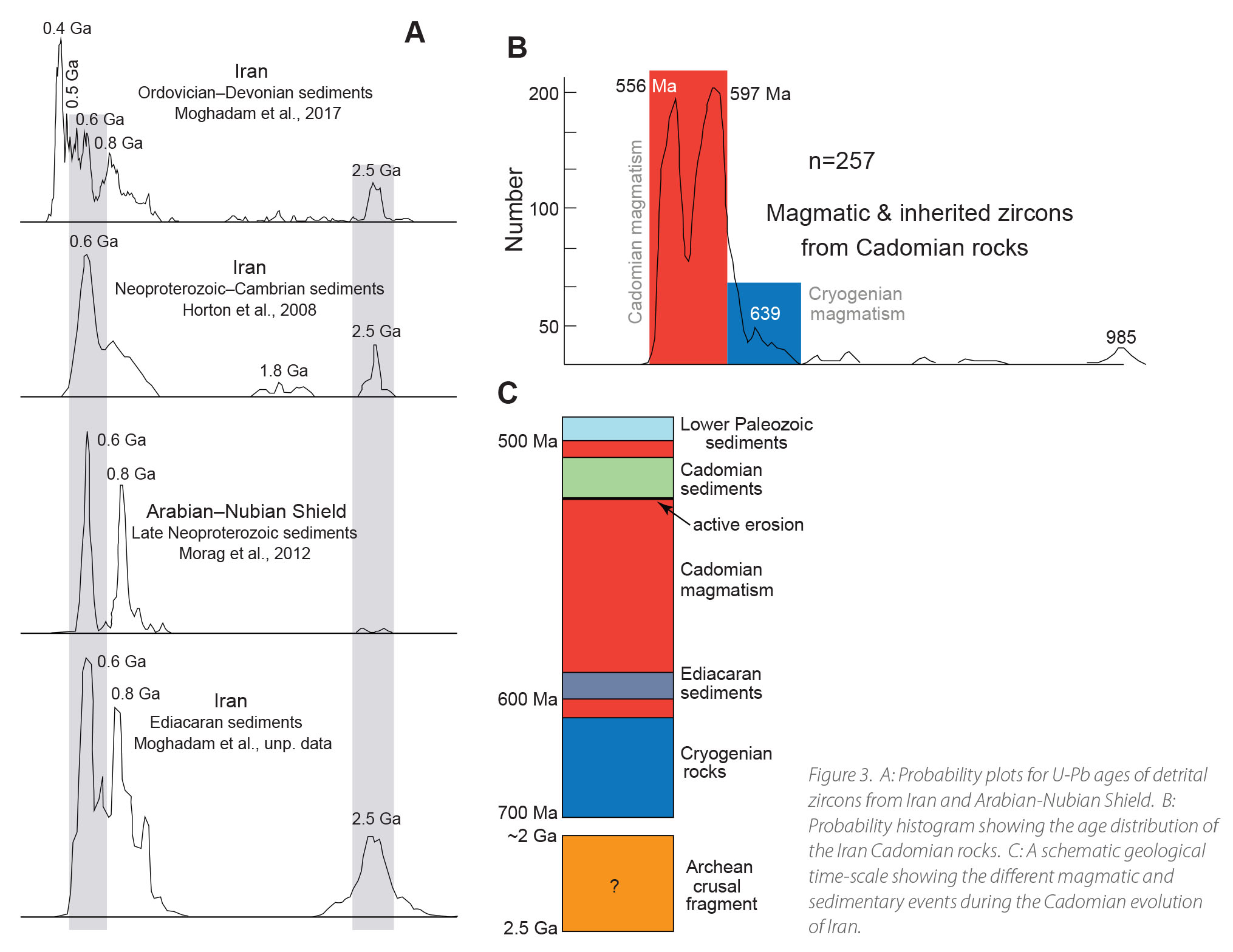
There is increasing evidence that a vigorous continental arc existed on the northern margin of the Greater Gondwana supercontinent during Late Ediacaran-Early Paleozoic time (500-600 Ma) (Fig. 1); this is referred to as the Cadomian orogen, although some segments, especially in the west, are called Avalonian. The Cadomian arc needs further study and this must use each of the outcrop areas that are now scattered across southern Europe and SW Asia. We are exploiting new zircon U-Pb-Hf-O as well as whole rock Sr-Nd isotopic data for a suite of Cadomian plutonic and volcanic rocks throughout Iran. Igneous rocks of the Cadomian arc were likely to have been dominated by development of calc-alkaline batholiths beneath thick sequences of felsic lavas, ignimbrites and arc-derived sediments, but these are rarely preserved. We are using these results to address the suitability of the magmatic flare-up model for understanding the Cadomian crust of this region and to address the thermal state of the Gondwana upper mantle and lower crust during that time span.
We have also analysed detrital zircons from a series of Late Neoproterozoic-Cambrian detrital sedimentary rocks to further unravel the role and extent of the Cadomian magmatism. Our results indicate that the Cadomian magmatism in Iran and surroundings, including Turkey, was a part of a ~100 Myr-long episode of subduction-related arc and back-arc magmatism at the northern margin of Gondwana. Zircon Hf isotope compositions (Fig. 2) show that during the Cadomian magmatic activity, juvenile arc magmas interacted with Archean crust to generate the Ediacaran-Cambrian igneous rocks. The hidden Archean crust is further evidenced by the occurrence of 2.5 Ga inherited zircons in the magmatic rocks and abundant magmatic, unrounded, Archean zircons in the sedimentary rocks (Fig. 3).

This project is part of CCFS Theme 2, Earth Evolution, and contributes to understanding Earth’s Architecture.
Contacts: Hadi Shafaii Moghadam, Bill Griffin, Sue O’Reilly
Funded by: CCFS Flagship Program 1
Isotopic canaries in zircon track Cu prospectivity across Southern Tibet
Porphyry deposits are the main source of copper and molybdenum worldwide and also an important source of gold and silver. Porphyry systems are found in both continental arcs and island arcs, e.g. circum-Pacific subduction zones, as well as continental collision zones, e.g. southern Tibet. Broadly, porphyry deposits are characterised by copper sulfide minerals in stockworks, disseminations and veinlets, commonly associated with porphyritic intrusions, affected by potassic, sericitic and in some cases, even argillic alteration (Sillitoe, 2010).
To gain new insights into the prospectivity and geologic setting of the Chongjiang (CJ), Gangjiang (GJ) and Bairong (BR) porphyry Cu prospects and the Tinggong (TG) porphyry Cu-Mo mine in the southern Lhasa terrane, southern Tibet, we use the new integrated approach published by Lu et al. (2016). The integrated approach includes the use of porphyry Cu fertility indicators based on traditional whole-rock geochemistry and new in situ zircon trace element analyses. Additional measurements included zircon U-Pb, Hf and O isotopes in order to better constrain magma sources and the petrogenetic evolution of the region.
Cu fertility indicators
Porphyry copper deposits are associated with hydrous and oxidised magmas at shallow crustal levels (Sillitoe, 2010). These hydrous magmas are characterised by high Sr/Y (>35), V/Sc (>10) and Al2O3/TiO2 (>25) ratios. To complement the previously mentioned whole-rock indicators, Lu et al. (2016) took advantage of the remarkable resilience of zircon and its ability to record tectono-magmatic evolution. Under the new approach it is possible to distinguish between fertile and infertile magmatic suites and evaluate tectonic processes that are identified from whole rock geochemistry. The method includes in situ measurements of trace elements in zircons. The best indicators of Cu fertility based on zircon compositions are zircon Eu/Eu* (>0.3) and 10,000*(Eu/Eu*)/Y (>1), while zircon (Ce/Nd)/Y (>0.01) and Dy/Yb (<0.3) have proven to be moderately useful. In addition, the zircon O- and Hf- isotope data provide insights into the sources and petrogenetic evolution of the porphyry systems.
Southern Tibet Miocene porphyry copper deposits
The Himalayan-Tibetan orogeny is the result of the amalgamation of three distinct terranes, from north to south, the Songpan-Ganze, Qiangtang, and Lhasa terranes. The Lhasa terrane is further subdivided into three sub-terranes as shown in Figure 1 (Hou et al., 2015). The amalgamation of these terranes resulted from the Indo-Asian continental collision that started in the early Tertiary. The southern margin of the Lhasa terrane hosts Miocene porphyry copper deposits estimated at 18 Mt of Cu with a value of approximately 126 billion US$.
Preliminary results of the zircon U-Pb, trace element, Hf and O data indicate that the prospects CJ, BR, and GJ are fertile for Cu mineralisation and that they formed in a compression environment resulting from the continental collision of India and Asia at ca 55 Ma. The O and Hf data show that the samples are mostly of juvenile origin but after ca 55 Ma there is an increasing involvement of supra-crustal material in the magma genesis, possibly due to subduction of Indian continental sediments into the Tibetan mantle source.
See CCFS publication # 811, Lu et.al. Society of Economic Geologists Special Publ. 19, 329-347.

This project is part of CCFS Theme 2, Earth Evolution, and contributes to understanding Earth’s Architecture and Fluid Fluxes.
Contacts: Luis Parra- Avila, Yongjun Lu, Marco Fiorentini, Robert Loucks
Funded by: CCFS Flagship Program 2
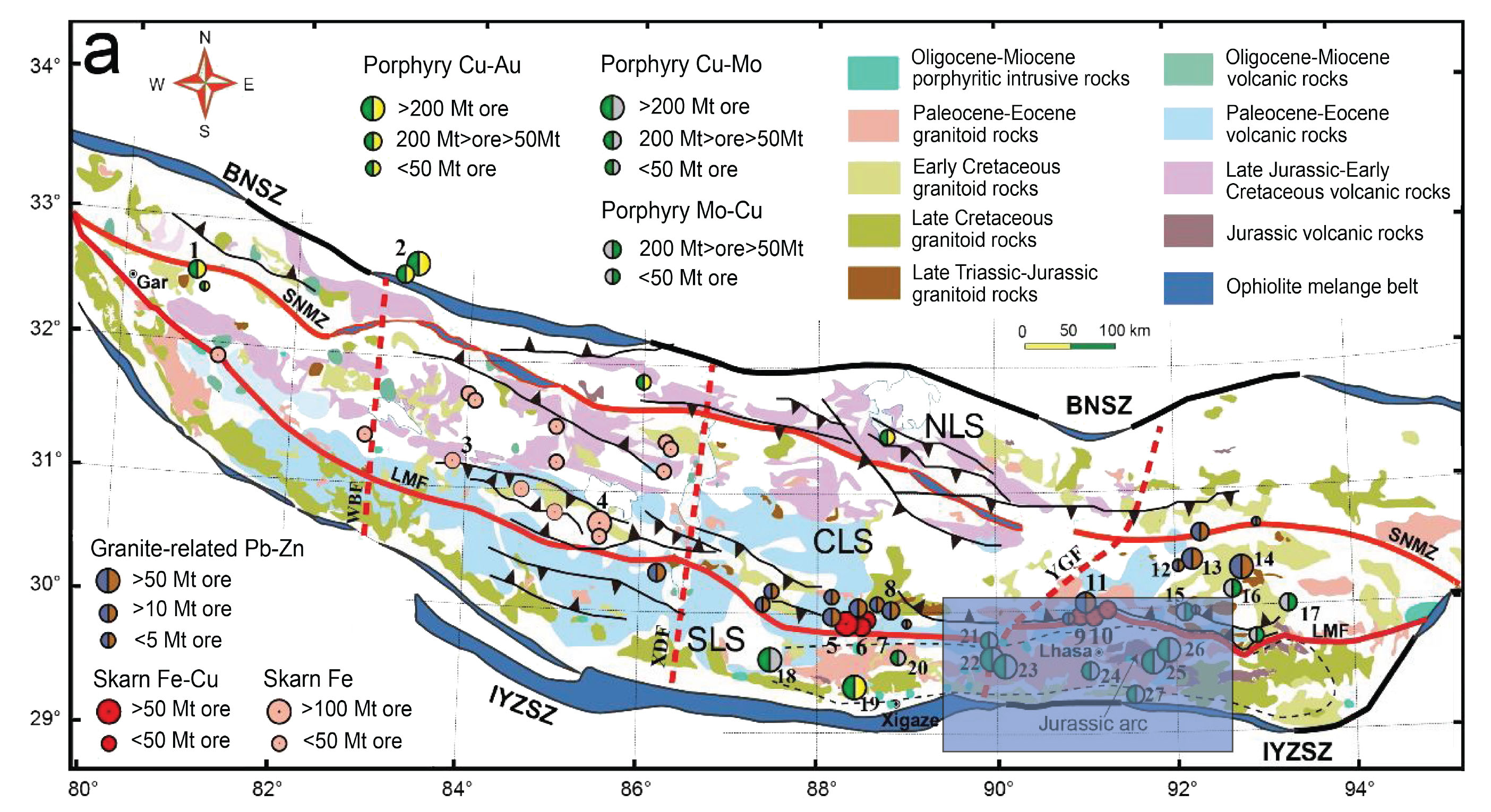
Figure 1. Simplified geological map of the Lhasa Terrane, and its sub-terranes, northern, central, and southern. Sub-terranes are cut by three Miocene normal fault systems: Wenbu, Xuru-Dangreyong, and Yadong-Gulu faults. Distribution of granitoid rocks and felsic volcanic rocks of the Lhasa terrane. Thick dashed red lines indicate N-S-trending normal fault systems. Thin dashed black line in eastern portion of the southern Lhasa sub-terrane indicates extent of a Jurassic magmatic arc (Hou et al., 2015). Blue box shows the location of the study area.
Astrobiology ‘Down under’: Visualising early life on Earth
The advent of virtual reality technologies and multi-scale 3D modelling in combination with geological mapping has allowed perspectives of geological outcrops never before explored.
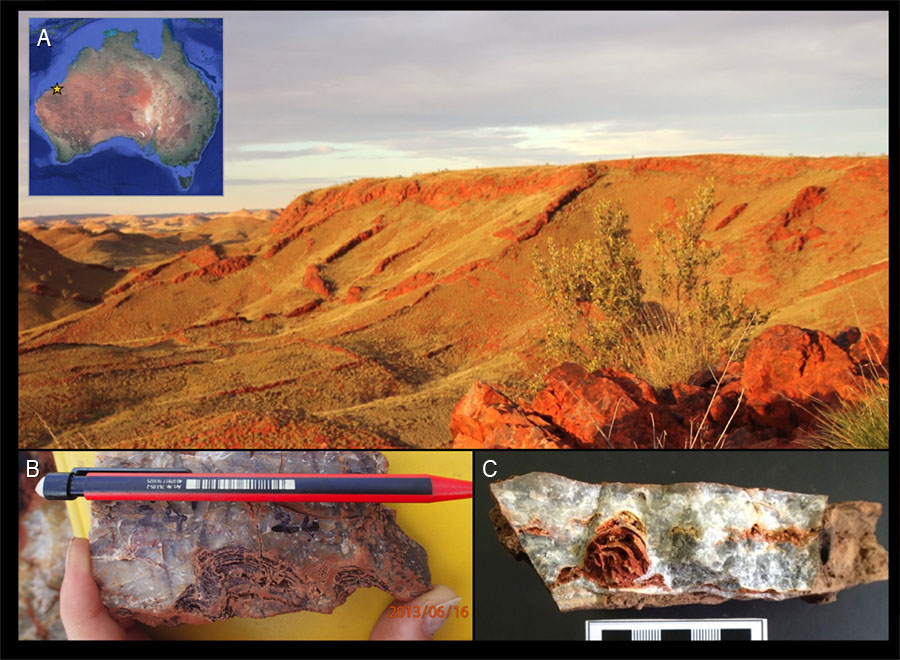
Figure 1. A. Location photo of the Dresser Formation. B-C. Signs of life: Stromatolites within the Dresser Formation - rock structures built by microbial life 3.5 billion yeas ago.
Over the past 30 years the world of virtual reality has emerged, not just for games but also for education and especially industry training. In recent years virtual reality has come back into the limelight and is better and cheaper than ever. Over the past 5 years, drones or Unmanned Aviation Vehicles (UAVs) have become relatively inexpensive and easy to use, with camera quality that reaches 4K. Meanwhile, point-and-shoot digital cameras provide easy-to-use, efficient, lightweight tools for capturing high-resolution images. These technologies provide an easy, inexpensive, way to collect and display visual data. This has significant applications in science, and especially for the visually-dependent disciplines such as the geosciences.
This research capitalises on the benefits of visual data capture, focusing on building a comprehensive virtual field trip (VFT) of a site that contains evidence for some of Earth’s earliest life, the ca 3.48 Ga Dresser Formation North Pole Dome, Pilbara Craton, Western Australia. Extensive detailed mapping, along with petrological and geochemical data from the Dresser Formation has provided a plethora of paleoenvironmental evidence showing that life was living in and around volcanic hot springs much like those found in Yellowstone National Park or the North Island of New Zealand. Rock structures built by microbes almost 3.5 billion years ago can be found in the ancient deposits (Fig. 1).
The VFT includes immersive geological outcrop visuals and photogrammetric imaging (3D models), and integrates detailed scientific observations from the macro- to the micro-scale i.e. outcrop to microscopic view, respectively (Fig. 2). Results aim to: 1. Enhance the environmental model for the Dresser Formation, developing a better understanding of why some of Earth’s earliest convincing evidence of life is in a volcanic hot-spring setting and; 2. Produce an interactive and immersive learning/educational tool - by way of a VFT - that can be used in online, face-to-face teaching, and as a research tool.
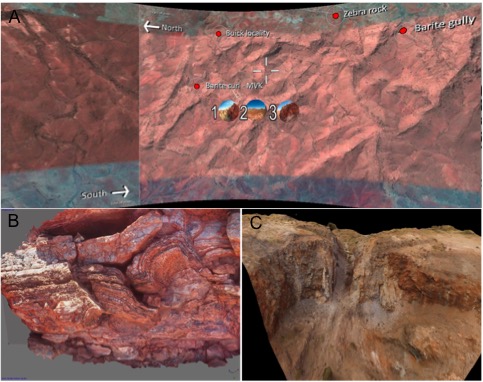
Figure 2. A. Map of the Dresser Formation within the Virtual Field Trip showing sites containing multiple 360° panoramas that contain detailed multimedia such as 3D models, photographs, micrographs and geo- chemical information. B. 3D model of stromatolites. FoV - 3 m. B. 3D model of local outcrop. FoV - 100 m.
The principles and practices of the VFT can be applied to other geological sites, perhaps even Mars. The VFT serves as an educational tool and as a visual aid in communicating science and early life on Earth as well as providing assessment for the use of immersive environments in education and scientific research.
In 2016, the Australian Centre for Astrobiology launched a pilot demonstration of the VFT at UNSW in the 3rd year astrobiology course (BEES6741: Life in the Universe). The students’ task was to go through the Dresser Formation VFT and then create a table of evidence and a 3 minute video describing what they had observed and interpreted about the environment based on their experience. This has proven to be a successful and fun exercise. In 2017, we aim to develop and enhance the VFT and launch a second pilot program in this year’s astrobiology course.

This project is part of CCFS Themes 1 and 2, Early Earth and Earth’s Evolution, and contributes to understanding Fluid Fluxes.
Contacts: Tara Djokic, Martin Van Kranendonk
Funded by: CCFS Flagship Program 4
Mineral gymnastics track subduction zone processes

All around the world, sections of deep Earth material are exposed in ophiolitic complexes and allow geologists to take a direct look at the deep crust, the transition zone and the underlying upper mantle. In the Moho transition zone as well as in the upper mantle, we find a characteristic layering - dunites and pyroxenites entangled with each other. The physical and chemical properties of the dunites, the most volumetrically important fraction in the upper mantle, have been extensively studied. Pyroxenites, despite being geochemically significant, have not received much attention from the mineral-physics point of view and their influence on upper-mantle rheology still remains unclear.
Figure 1. Typical outcrop of massive pyroxenites in the Cabo Ortegal complex. Dunites (yellowish layers) are interlayered with massive pyroxenites (green- greyish layers). Deformation markers such as boudinage can be easily observed.
In north-western Spain, the Cabo Ortegal massif makes up a spectacular field occurrence of deformed interlayered pyroxenites and dunites. Such outcrops constitute a fantastic natural laboratory to investigate how deformation affects a pyroxene-rich domain.
Field and geochemical evidence has defined four different types of pyroxenites: type-1 are olivine-bearing clinopyroxenites enclosing dunitic lenses, and are interpreted as partial replacement of the host peridotite; type-2 are massive websterites representing either more evolved products of the melt/rock interaction that led to type-1 pyroxenites, or crystal cumulates in dykes and veins; type-3 are foliated amphibole-rich clinopyroxenites with evidence of significant fluid percolation; and type-4 represent the rare orthopyroxenites. We performed a petrological and textural characterisation of the different pyroxenites by Electron Backscatter Diffraction (EBSD). Combination of the results with field evidence revealed that at least two superimposed deformation events have been recorded by the Cabo Ortegal pyroxenites.

Figure 2. Microstructure of the pyroxenites plotted from EBSD data. These maps of misorientation to mean orientation indicate the angular deviation between each measurement (i.e. pixel) and the mean orientation of the grain it belongs to. A: Misorientation to mean orientation for clinopyroxenes. Misorientations are concentrated in the external part of the grain and at subgrain boundaries. B: Misorientation to mean orientation for orthopyroxenes. Misorientations are here concentrated in kink bands and form the spectacular undulose extinction one can see in thin sections.
The most ancient event is suggested by the olivine and clinopyroxene fabrics and is likely to have occurred at temperatures greater than 1000°C in a hydrated environment. Such deformation conditions are consistent with the mantle wedge setting that has been already suggested by geochemical data. The second deformation event is recorded by the amphibole and occurred at lower temperature (500 to 800°C). This event is synchronous with the development of the spectacular sheath folds observed in the field and is consistent with close proximity to a slab.
Based on this new evidence, we argue that the Cabo Ortegal pyroxenites record mantle wedge deformation during the massive delamination of the arc root where it was generated. Our results are also consistent with the exhumation of the massif by its introduction into a subduction channel. Cabo Ortegal pyroxenites are therefore an incredible opportunity to have a look at the physical state of a piece of delaminated arc root and observe the impact of pyroxenes on the local rheology.

This project is part of CCFS Themes 2 and 3, Earth’s Evolution and Earth Today, and contributes to understanding Earth’s Architecture and Fluid Fluxes.
Contacts: Hadrien Henry, Romain Tilhac, Sue O’Reilly, Bill Griffin, Georges Ceuleneer (Géosciences Environnement Toulouse, GET, France)
Funded by: CCFS Flagship Program 1, Two iMQRES scholarships and cotutelle programs between Macquarie and Paul Sabatier University, EPS postgraduate funds, CNRS funds (G. Ceuleneer)
Recognising where magma moves 40 km underground
Earth has a heterogeneous, layered crust that overlies a relatively homogeneous mantle. Every day, magma erupts from volcanoes around the world to form lava and other eruptive rock types. The geochemical signature of these volcanic rocks tells us that in most cases the source of the magma (i.e. the deep rocks that partially melted) includes both mantle and crustal components that are tens to even hundreds of kilometres deep in the Earth. Therefore, these partial melts must migrate from the deep Earth to the surface, yet geological pathways are difficult to recognise. Although some pathways are seen as dykes and shear zones, few are documented to be associated with mass transfer. Consequently, there must exist structures that are yet to be recognised as zones of substantial mass transfer.
Elongate bodies of rocks very rich in iron and magnesium, with low silica (< 45 wt%), are ubiquitous in exposures of the deep crust (exhumed from 25-50 km). Hornblendite bodies (rocks mainly comprising the mineral hornblende) of the Pembroke Valley, north of Milford Sound in New Zealand, are hosted within granulite-facies gabbroic gneiss and are typical of such occurrences. These examples have igneous grain shapes and mineral textures, in contrast with the metamorphic character of their host gneiss.
Both rock types have a common gabbroic parent; field relationships are consistent with modification to gabbroic gneiss and then into hornblendite. Although the hornblendite looks like a cumulate rock, where hornblende grains settled and concentrated in a magma chamber, the field relationships preclude this interpretation; these bodies are imposter cumulates. Instead, hornblendite formed when the host gabbroic gneiss was replaced because of channelled melt flux through the lower crust. High melt/rock ratios and disequilibrium between the migrating magma and the gabbroic gneiss induced dissolution (grain-scale magmatic assimilation) of the gneiss and crystallisation of hornblende from the migrating magma. The extent of this reaction-replacement mechanism indicates that such hornblendite bodies mark significant melt conduits. Accordingly, many of the ubiquitous elongate bodies rich in iron and magnesium of the lower crust probably map the ‘missing’ mass-transfer zones.
The dissolution of plagioclase and pyroxene from the gabbroic gneiss and crystallisation of mainly hornblende marks a reactive period of melt-rock interaction. Once all the plagioclase and pyroxene of the host rock has reacted out of the channel of magma migration, it becomes an armoured channel.
At this stage, magma can migrate through the channel without modification or chemical interaction with wall rocks. An indeterminate volume of melt could then use the channel, moving large volumes of melt through the crust. See CCFS Publication #832, Daczko et.al., Scientific Reports, 2016, 6, 31369.

Figure 1. (a) Excellent exposure of an interpreted melt flux channel (30-40 m wide dark rock outlined by dashed lines, left to right) being mapped by Masters of Research students Uvana Meek and Victoria Elliott. (b) Photomicrograph of hornblendite (right) and garnetite stringer (left) from within the melt flux channel. (c-e) Back-scattered electron images of low dihedral angles, films along grain boundaries and small pockets representing the crystallsation of former melt, along with well-developed crystal faces at unlike mineral boundaries (e.g. plagioclase-hornblende boundaries in upper left of e). Mineral labels are plagioclase (p, yellow arrows), hornblende (h, white arrows), biotite (b) and garnet (g).

This project is part of CCFS Theme 2, Earth’s Evolution, and contributes to understanding Earth’s Architecture and Fluid Fluxes.
Contacts: Nathan Daczko, Sandra Piazolo
Funded by: ARC DP (SP and ND), ARC Future Fellowship (SP)
Ancient sulfur species recycled into younger igneous rocks
Cratonic margins are structurally and magmatically complex areas of the Earth’s crust, and often have been affected by one or more orogenic cycles. Several studies (e.g. Foley, 2008; Begg et al., 2010; Mole et al., 2014) have argued that Archean lithospheric block margins exerted a first-order control on the ascent and focusing of mantle plumes that lead to the emplacement of hot magmas, host to orthomagmatic Ni-Cu-PGE deposits, and associated Au and base metal hydrothermal systems. The presence of trans-lithospheric faults along craton margins would help to focus fluids and metals, while mantle plumes provided a source of energy to drive ore-formation processes (e.g. Mole et al., 2013). Younger orogenic belts formed during the Proterozoic or Phanerozoic around Archean lithospheric blocks also are prospective for the presence of metal deposits (e.g. iron oxide Cu-Au, orogenic Au, porphyry Cu-Ag; Groves et al., 2005), suggesting that the cratonic margins continued to focus mineralisation. Therefore, it is important to elucidate the processes that drive volatiles and their associated metal cargoes into orogenic belts at the margins of reworked Archean Cratons.
Sulfur resides in the Earth’s mantle, crust and hydrosphere but is locally concentrated in mineralised systems, where it acts as the primary complexing ligand in the formation of sulfide minerals. Mantle- and crustally-derived magmas have brought large quantities of economic metals from the Earth’s interior to the near surface, and hydrothermal fluids have remobilised and re-precipitated these metals within the crust as different sulfides. The sulfur itself may be sourced from a variety of compositional reservoirs, each with distinct isotopic compositions. Mixing and interactions with the mantle, crustal magmas, hydrothermal fluids, country rocks, or meteoric waters imparts specific isotopic signatures, resulting in minerals with a range of isotopic compositions. Intra-grain and inter-grain chemical and isotopic variations in sulfur-rich mineralised systems record the interaction of these different reservoirs and offer unique insights into the complex fluid-rock interactions within mineral systems (McCuaig et al., 2010).
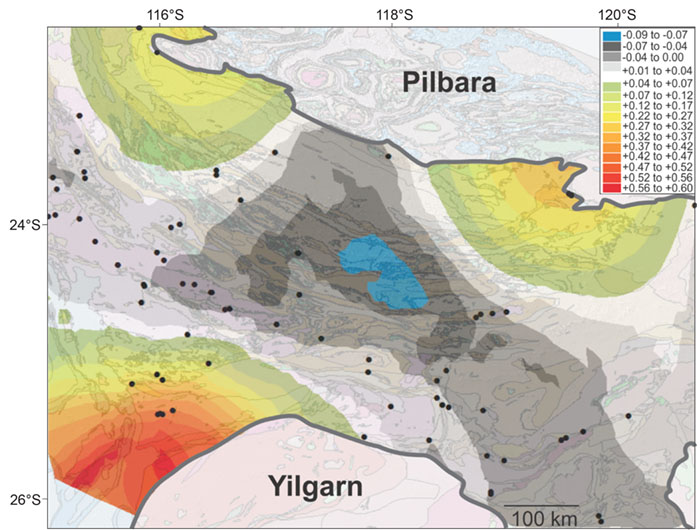
Figure 1. Δ33S interpolated model of the Proterozoic Capricorn Orogen demonstrating MIF-S anomalies proximal to the Archean cratons.
Understanding the cycling of sulfur and metals from Archean cratons into their margins can be explored using δ34S - the isotopic tracer sensitive to physical processes of formation - and Δ33S and Δ36S. The Δ33S and Δ36S anomalies express Mass-Independent Fractionation (MIF) - the production of sulfur isotopes by ultraviolet irradiation of a sulfur-rich atmosphere in Archean time, when Earth was not shielded by the oxygen and ozone in the atmosphere. These anomalies thus can be used as temporal tracers sensitive to the Archean-Proterozoic transition, like putting dye in watersheds to see how water travels.
The Capricorn Orogen is a natural laboratory to understand fluid, volatile and metal transfer to the margins of metal-endowed Archean cratons. The rocks making up the cratonic margins have long histories of deformation and hydrothermal fluid alteration. Results at the orogen-scale combined with detailed studies of ore deposits, help to track the mixing of geochemical reservoirs. The Proterozoic Capricorn Orogen records Δ33S values that range from −0.07‰ to +0.80‰. Spatially, data from this study show that ancient sulfur, with geochemical signatures indicating formation by mass-independent fractionation, in the Capricorn Orogen occur in localised areas, especially near to the margins of Archean cratons (Fig. 1). We suggest that the spatially localised Δ33S anomalies in Proterozoic samples, and the Archean Δ33S-Δ36S array of -1 (Fig. 2) reflect a recycled MIF-Sulfur component, rather than a primary signature. This evidence indicates that MIF-Sulfur can be imparted to the Paleoproterozoic granitoid and hydrothermal record through tectonically-driven crustal formation processes.

Figure 2. Δ33S/Δ36S diagram for samples containing a Δ33S anomaly (>0.1‰). Samples yield a Δ33S-Δ36S array with a slope of -1, typical of primary Archean sedimentary sulfur.
The units hosting Archean-sourced MIF-Sulfur are dominantly magmatic (granitoids associated with collision and intraplate reworking) and hydrothermal (mineralised samples associated with faulting and veining). Other mineral deposits that preserve MIF-Sulfur anomalies occur in collisional (ca 2.0 Ga Glenburgh deposit; Selvaraja et al. in review) and intracontinental-reworking settings (ca 1.8 Ga Prairie Downs deposit; this study). Therefore, we propose that magmatic and hydrothermal events associated with collision and intracontinental reworking processes are responsible not only for recycling sulfur across terrain boundaries, but also for transferring metals from endowed Archean reservoirs into their younger margins.

This project is part of CCFS Theme 2, Earth’s Evolution, and contributes to understanding Earth’s Architecture and Fluid Fluxes.
Contacts: Crystal LaFlamme, Marco Fiorentini, Boswell Wing, Mark Lindsay, Vikraman Selvaraja
Funded by: MRIWA
Is the Ammassalik Intrusive Complex (South East Greenland) part of an ancient Ni-Cu magmatic province?
The Paleoproterozoic Ammassalik Intrusive Complex formed during the Nagssugtoqidian orogeny, at the juncture of two Archean cratons, the Rae to the north, and the North Atlantic craton to the south (Fig. 1). The Ammassalik Intrusive Complex can be separated into three smaller complexes: the Johan Petersen, Tasiilaq and Kulusuk Intrusive Complexes, hosted in a ca ≤1990 Ma anatectic Bt-Gt paragneiss. The Ammassalik Intrusive Complex is interpreted to have been emplaced either as a dyke, later boudinaged, or as a series of pipes, at mid- to lower-crustal levels (granulite facies) in two successive pulses between ca 1915 and 1865 Ma.
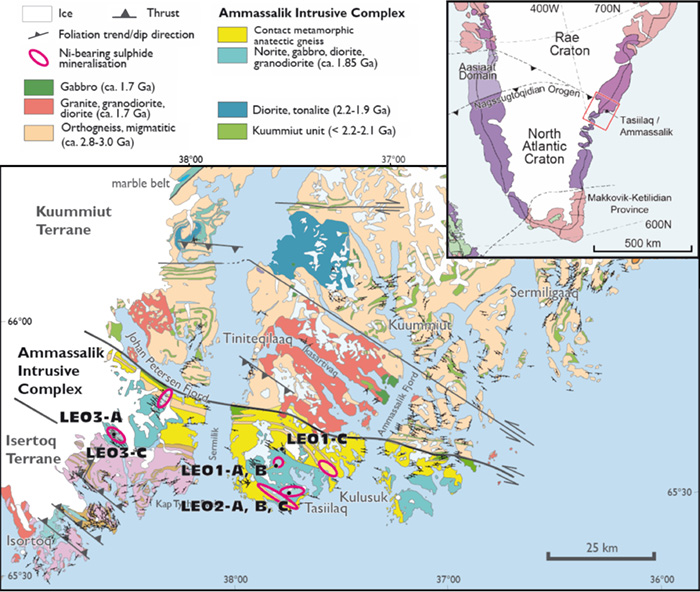
Figure 1. Detailed geology map of the Ammassalik Intrusive Complex. Geochronological samples are highlighted in black. Modified from Kolb (2014), Árting (2016) and Johannesen (2016).
Both the igneous rocks and the hosting Bt-Gt paragneiss show typical calc-alkaline and continental-arc signatures, including negative Ta, Nb and Ti anomalies. In addition, the fractionation of the MREE to HREE observed in the igneous samples, but not in the paragneiss, is consistent with a deep Gt-rich source. The igneous rocks of the Ammassalik Intrusive Complex can be sourced from partial melting of a Gt-lherzolite mantle, an eclogitic lithospheric mantle-wedge, or an eclogitic lower crust. However, each of these sources should have very different isotopic signatures.
Isotopic work on the igneous rocks of the Ammassalik Intrusive Complex suggests a mixture of sources. These sources represent mantle-derived magmas (from either the Gt-lherzolite mantle, or the lithospheric mantle-wedge) that assimilated and/or partially melted Paleoproterozoic to Archean supracrustal material on their way up through the mid- to lower crust. The host Bt-Gt paragneiss may have contributed to this supracrustal input and may be the source of the calc-alkaline and continental-arc geochemical signature of the igneous rocks. In detail, isotopic data (Fig. 2) show CHUR-like εHf values decreasing with time to around -10, interpreted to represent mixing of melts from a deep Gt-rich mantle with increasing partial melting and/or assimilation of Precambrian to Archean supracrustal material through time (TCDM for igneous rocks bracketed between 2320 and 3280 Ma). This mantle-crust mixing is further supported by bimodal supracrustal δ18O values around 7 and 9‰, above the ‘primitive mantle zircon’ range. The bimodal distribution may indicate a change through time in the type of supracrustal material involved. The isotopic composition of anatectic zircons in the Bt-Gt paragneiss also suggest that the Bt-Gt paragneiss was part of the supracrustal contribution.
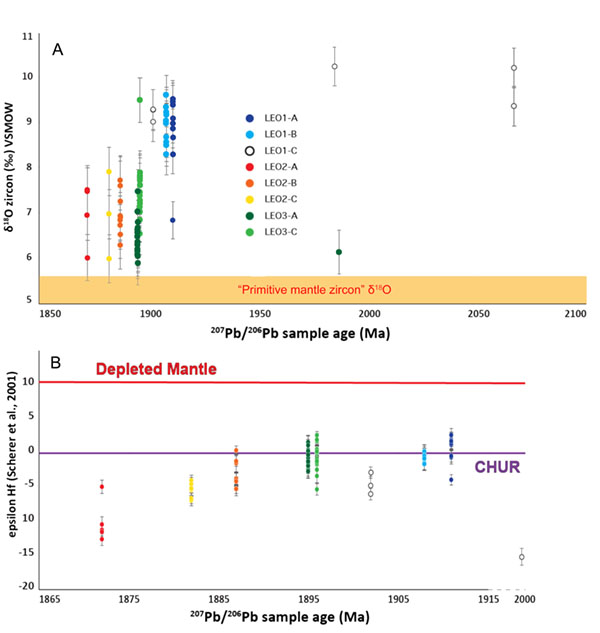
Figure 2. A) Diagram of the δ18O values for the igneous rocks from the Ammassalik Intrusive Complex, and Bt-Gt paragneiss. Primitive mantle zircon range from Valley et al. (2005). B) Lu-Hf data. CHUR: chondritic uniform reservoir.
The age bracket on the magmatism, between ca 1915 and 1865 Ma, overlaps with that of magmatism linked to the assembly of the Columbia supercontinent. This process was marked by the formation of numerous world-class Ni-Cu deposits around the world, some intrusive-hosted. Based on the age overlap and the paleoreconstruction of the supercontinent around 1.9 Ga, we interpret the Ammasalik Intrusive Complex and the south-eastern Greenland region as a direct continuation of the Svecofennian Province and the well Ni-endowed Kotalahti belt, along a circum-Rae magmatic province (Fig. 3). This conclusion highlights the high prospectivity of the south-eastern Greenland region for world-class intrusion-hosted Ni-sulfide deposits.

This project is part of CCFS Theme 2, Earth’s Evolution, and contributes to understanding Earth’s Architecture and Fluid Fluxes.
Contacts: Erwann Lebrun, Marco Fiorentini
Funded by: CCFS Flagship Program 2
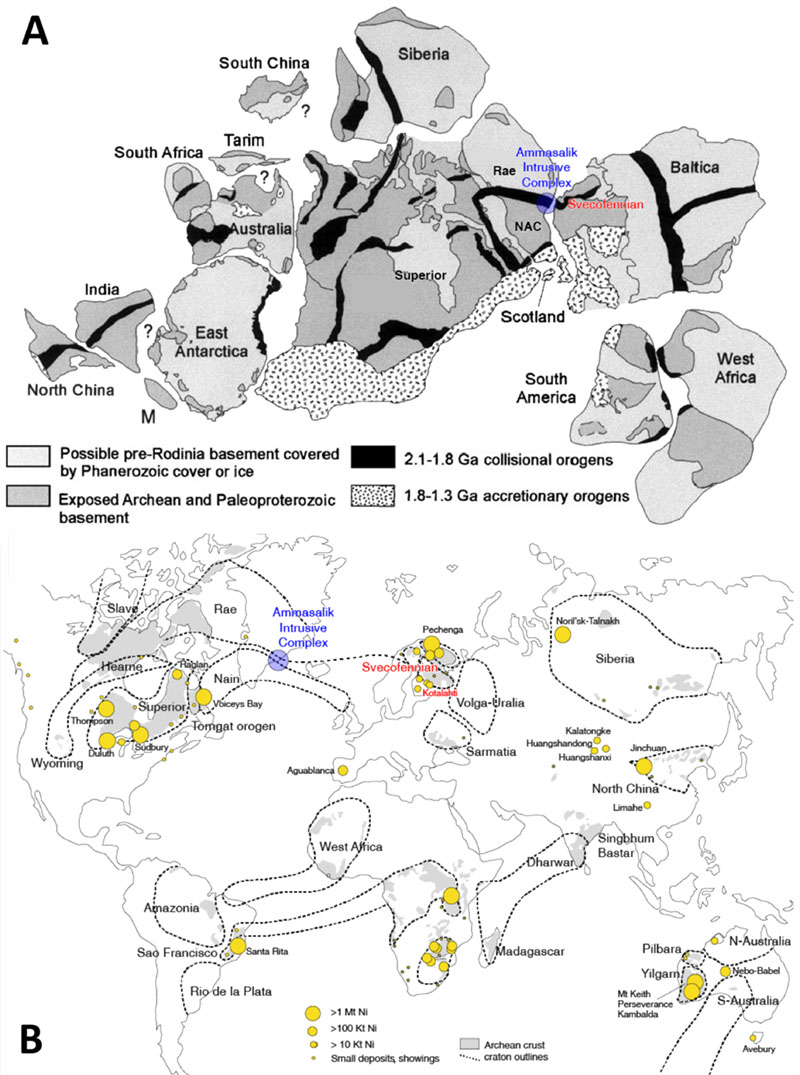
Figure 3. Reconstruction of A) the Columbia supercontinent showing the paleo- continuity between the Svecofennian Province and the Ammassalik region of south-eastern Greenland. Modified from Zhao et al. (2004). B) craton margins (modified from Bleeker, 2003) and associated Ni deposits highlighting the well-endowed Svecofennian Province and Kotalahti Ni belt and the link with south- eastern Greenland. Modified from Maier and Groves (2011).
Volcanic debris from up to 60 km beneath western Victoria tracks tectonic ups and downs
Subduction can draw surface, near-surface and shallow mantle materials (including volatiles) into the mantle and result in mantle/fluid interactions. The process plays a key role in cycling of volatiles and other elements and affects the composition and nature of Earth’s deep interior. Pyroxenite xenoliths from ~30-60 km below the surface, provide a key tool to track these deep processes. The basanite tuffs of Bullenmerri and Gnotuk maars, southeast Australia, contain abundant garnet-bearing pyroxenite xenoliths. New petrographic, geochemical and isotopic investigations on these xenoliths reveal a picture of subduction-related magmatism at mantle depths.
Microstructural evidence of the exsolution of garnet (± orthopyroxene ± spinel ± plagioclase ± ilmenite) from complex clinopyroxene megacrysts suggest that all garnet pyroxenite xenoliths originally were clinopyroxene-dominant cumulates, modified by exsolution and recrystallisation during cooling to the ambient geotherm (Fig. 1). They can be divided into two types: Type I high-MgO garnet websterites, and Type II low-MgO garnet clinopyroxenites. The high-MgO garnet websterites have high Cr and low Al contents in both whole rock and clinopyroxene, relatively flat LREE patterns and homogeneous Sr-Nd-Hf isotopic compositions (87Sr/86Sr=0.70386-0.70657; 143Nd/144Nd=0.51260-0.51283; 176Hf/177Hf=0.28281-0.28305). These data suggest that they represent high-pressure cumulates from arc-related tholeiites, produced in the initial stages of partial melting of a mantle wedge due to slab dehydration. Conventional thermobarometry and thermodynamic modeling on the reconstructed clinopyroxene indicate that the primary clinopyroxenites crystallised at ~1420-1460 °C and 23-30 kb and finally equilibrated at ~982-1094°C and 14-17 kb.
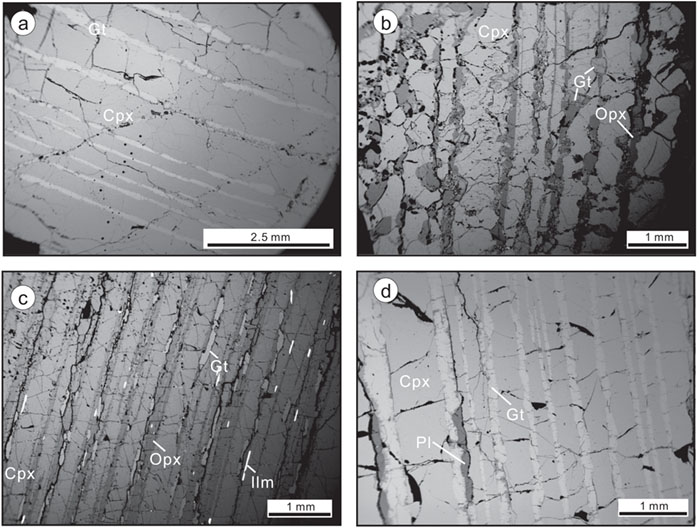
Figure 1. Backscattered electron (BSE) photomicrographs of clinopyroxene megacrysts with exsolution lamellae of garnet (Gt), orthopyroxene (Opx), ilmenite (Ilm) and plagioclase (Pl).
Low-MgO clinopyroxenites have low Cr contents and variable REE patterns from LREE-depleted to LREE-enriched in the whole rock and clinopyroxene. They also show heterogeneous Sr-Nd-Hf isotopic compositions (87Sr/86Sr=0.70374-0.71548; 143Nd/144Nd=0.51221-0.51355; 176Hf/177Hf=0.28274-0.28396) in clinopyroxene but uncontaminated upper-mantle δ18OV-SMOW in garnet (4.9-5.2 ‰), indicating that low-MgO pyroxenites may represent high pressure cumulates from an evolved magma derived from partial melting of hydrothermally altered oceanic crust with the addition of subducted sediments from the Paleozoic Lachlan orogenic belt. P-T calculations suggest that they crystallised at 1280-1400°C and 16-20 kb and finally equilibrated at 950-1050 °C and 12-17 kb.
The preservation of fractionated trace-element patterns in multiple generations of garnet lamellae and their surrounding clinopyroxene indicates a decompresssional cooling path (1032 °C and 21 kb) before the xenoliths were entrained by the host basanite (Fig. 2).
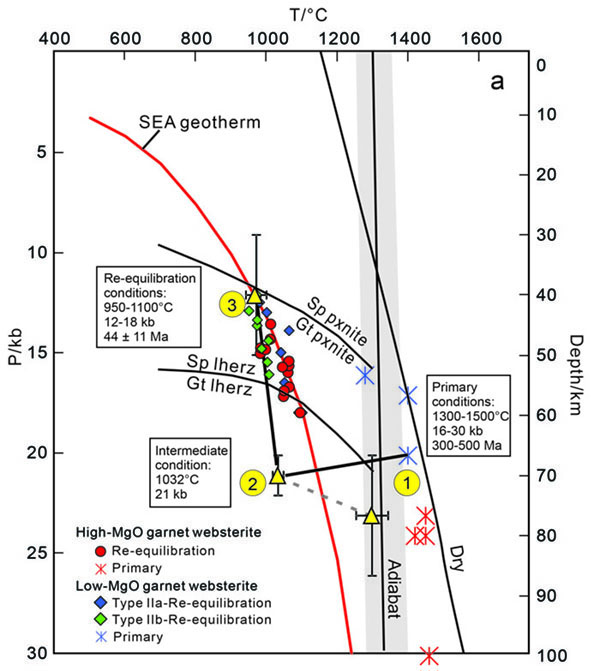
Figure 2. P-T-t path for the garnet pyroxenites from Lakes Bullenmerri and Gnotuk.
These results imply that the protoliths of the garnet pyroxenite formed at a range of depths from ~50-100 km; back-calculation of the isotopic data suggests this primary crystallisation occurred about 300-500 m.y. ago. During, or shortly after cooling, they were tectonically uplifted to higher levels (~40-60 km; i.e. uplifted by at least 10~20 km) in Paleogene time (44 ± 11 Ma; Sm-Nd isochrons); this was accompanied by rifting associated with crustal inflation and thinning in southeast Australia.

This project is part of CCFS Theme 2, Earth’s Evolution, and contributes to understanding Earth’s Architecture and Fluid Fluxes.
Contacts: Jianggu Lu, Bill Griffin, Sue O’Reilly, Qing Xiong, Jin-Xiang Huang, Norman Pearson, Jianping Zheng (China University of Geosciences, Wuhan)
Funded by: CCFS Flagship Program 1, IMQRES scholarships
Earth’s magnetic switch activated in the deepest mantle
Earth scientists use paleomagnetism to establish a paleogeographic framework for continental blocks through Earth’s history. Rapid changes in the geomagnetic field also provide critical information about Earth’s long-term evolution and dynamics. In particular, dynamic activity at the core-mantle boundary impact on the behaviour of the geomagnetic field by changing the rate and geometry of the heat flux field. For instance, the lower mantle impacts on the geomagnetic reversal rate. It has also been suggested that heterogeneity in heat flux causes specific patterns of transitional paleomagnetic poles (or virtual geomagnetic poles - VGPs) during the reversal of the geomagnetic polarity. For example, transitional poles may be arranged on the rims of the large low shear velocity provinces (LLSVPs) near the core-mantle boundary. If proven, this relationship potentially can provide important constraints on the stability of LLSVPs over time, which has a direct influence on the concept of the supercontinent cycle.
In this study we investigated a sedimentary sequence from Armenia, where the two geomagnetic field reversals bounding the youngest normal-polarity subchron (the so called Jaramillo subchron with an age between 0.988 and 1.072 Ma), prior to the current Brunhes normal-polarity chron, have been recorded. The paleomagnetic signal in the sediments is of very high quality and, because these lake deposits accumulated very rapidly (~30 cm/ka), it was possible to study the field reversals over a thickness of ~2 m. We obtained standard, 1 inch diameter, paleomagnetic samples at intervals of less than 10 cm. Based on the paleomagnetic results we calculated, at each sample level, a geomagnetic pole assuming a dipole-dominated geomagnetic field (therefore virtual geomagnetic poles). Plotting these poles allowed us to investigate the appearance of the geomagnetic field during a polarity transition (or field reversal).
The obtained virtual geomagnetic pole (VGP) path indicates an oscillatory transitional field behaviour with four abrupt transequatorial precursory jumps across the Pacific (Fig. 1). The two records are strikingly similar to another high-quality paleomagnetic record (green points in Fig. 1), which is based on a volcanic sequence from Tahiti. The distribution of VGP positions of these three records clearly indicate regions of preferred occurrence (Fig. 2). Our results are in agreement with previously proposed bands of transitional VGP over the Americas and Australia/northwest Pacific zone, almost exclusively over the girdle of mantle downwelling between the two large provinces of low shear velocity (LLSVPs; Fig. 2).
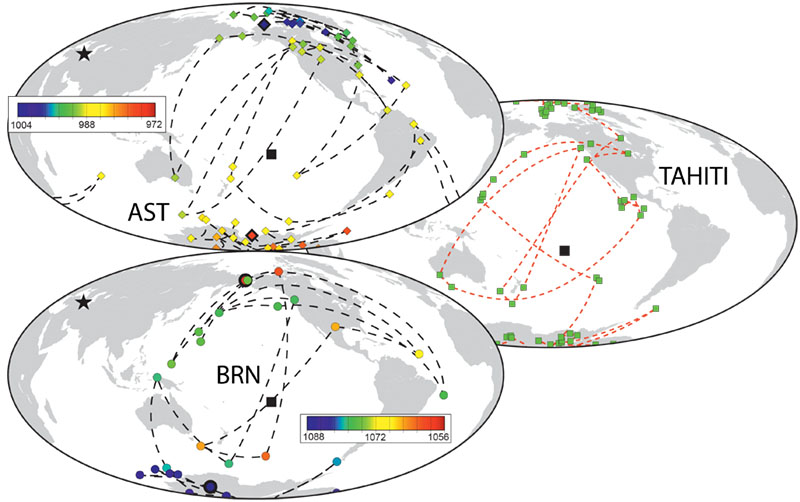
Figure 1. Virtual Geomagnetic Pole (VGP) paths of Armenian sections Ashotavan-2 (AST) and Brnakot-2 (BRN) together with the VGP path of volcanic sequence in Tahiti (Chauvin et al., Journal of Geophysical Research, 95, 1990 VGPs are colour coded with the inferred age in ka. Black star (square) indicates the location of the reversal records of this study (Tahiti).
Our observations imply a thermally stable zone within the outer core and below the LLSVPs, which persists throughout the polarity transition. This zone can generate a secondary radial dipole, which repels the transitional VGPs directly above this zone. As long as the LLSVPs are in place, all polarity transitions should look similar, as observed for the youngest polarity transitions.
Our work further demonstrates that there is an obvious link between the geometries of paleomagnetic reversals and lower-mantle structures. In future studies we may use this as a basis for investigating the temporal evolution of the lower mantle after identifying high-quality reversal records from older sequences. We show that with only three high quality records and a robust statistical analysis we can visualise an antipodal structure at the CMB. Such work will help us to evaluate how stable these features at the CMB actually are.

This project is part of CCFS Theme 2, Earth’s Evolution, and contributes to understanding Earth’s Architecture and Fluid Fluxes.
Contacts: Uwe Kirscher, Valerian Bachtadse
Funded by: CCFS Flagship Program 5, ARC Laureate Fellowship (FL150100133), DFG grant (Ba1210/14-1)
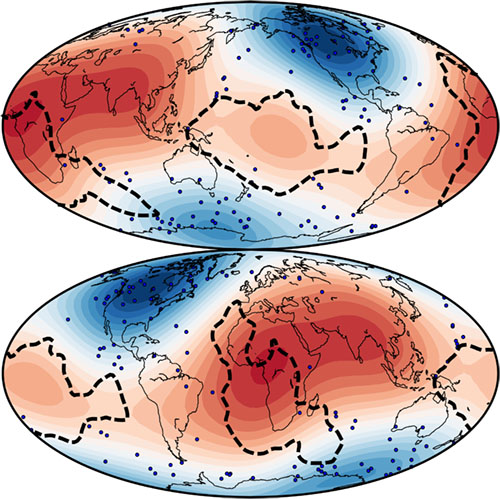
Figure 2. Stereographic projection of calculated VGPs of all studied samples (blue points) together with VGPs of a record from Tahiti (s.a.). Present day LLSVPs at the core-mantle boundary are outlines by black dotted lines. The reddish to bluish colour corresponds to a Gaussian kernel density estimate of the VGPs. Dark blue colours represent areas where VGPs are most likely to be found, while red colours represent areas which seem to be avoided by VPGs.
Sulfur isotopes reveal the evolution of mineralised Komatiites
Komatiites are ancient submarine lavas erupted over 2.5 billion years ago. Their ultramafic chemical compositions and the exceptionally high temperatures (~1600 ºC) of the lavas allowed them to form spectacular channelised lava flows that find present-day analogues in the Kilauea lava fields of Hawaii. Their high temperature and low viscosity let komatiites lavas flow turbulently and to mechanically and thermally erode and assimilate crustal substrates along their path.
Komatiites are economically important because they can host massive sulfide mineralisation enriched in Ni, Cu and platinum-group elements (PGE). Indeed, komatiite-hosted Ni-Cu-PGE deposits from the Yilgarn Craton, Western Australia, account for ca 20% of global Ni-sulfide resources. Current models suggest that the assimilation of crustal sulfur-rich material by komatiite-lava erosion was necessary for sulfide supersaturation and deposition of these deposits.
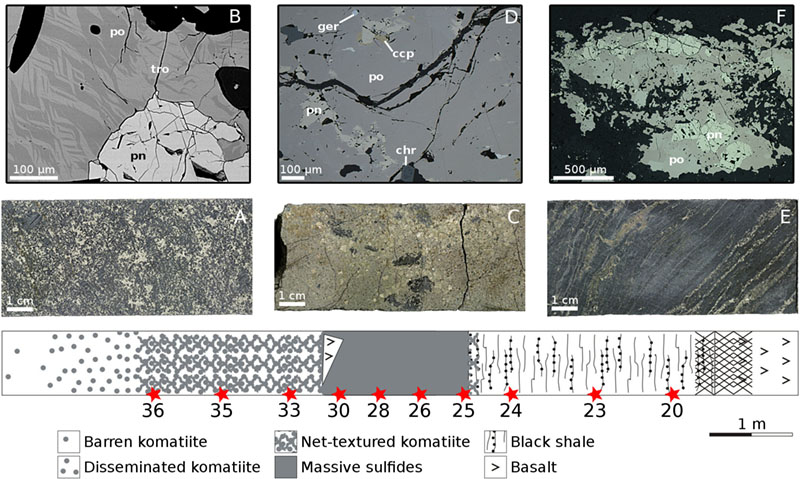
Figure 1. Scheme of the studied drillcore from the Wannaway Ni-Cu-PGE deposit, Western Australia. A) Drillcore section of net-textured komatiite; (B) BSE micro-image of net-textured sulfides; (C) Drillcore section of magmatic massive sulfides; (D) Optical reflected-light micro-image of massive sulfides; (E) Drillcore section of basal black shale; (F) Optical reflected-light micro-image of sedimentary sulfides.
This study combined mineralogical and sulfur-isotope variations to evaluate magmatic processes involved in the evolution of the ore-bearing sequence at Wannaway (Eastern Goldfields). It also provides a perspective on the potential influence of such processes on the composition of the Archean atmosphere.
The mineralised successions comprise basal sufide-rich black shales overlain by komatiite-hosted sulfides manifested by gradual transitions from massive to matrix-textured and disseminated ores (Fig. 1). We analysed the S-isotope composition of samples taken at regular distances through the mineralised sequence and then correlated sulfur mass-dependent fractionation (MDF-S) signatures with recently discovered mass-independent fractionation (MIF-S) signatures to better constrain the effect of subsequent fractionation. The magmatic sulfides show a distinct positive MIF-S signature which indicates the assimilation of crustal material. The isotopic signatures of the sulfides are analogous to the sediments directly underlying the komatiite flows, suggesting that the assimilation occurred in situ. The data suggest that over 1/3 of the total sulfur in the deposit was assimilated from the country rocks.
In addition, the magmatic sulfides display a wide range in MDF-S signatures that gradually become lighter from the basal massive sulfides upwards. This isotopic drift is followed by the appearance of troilite (FeS) and a gradual decrease of pyrrhotite (Fe1-xS) proportions. At stratigraphic levels where troilite becomes dominant, alabandite (MnS) appears; this is an unusual phase commonly related to strongly anoxic sedimentary environments and observed in meteorites. We argue that the combined upwards decrease in heavy sulfur isotopes along with the stability of troilite and alabandite is a consequence of magmatic devolatilisation and the release of SO2-rich gasses during emplacement. The release of SO2 would have stripped ‘heavy’ sulfur from the komatiite magma, and caused local decreases in oxygen fugacity. This phenomenon, which is widely observed in present-day lava eruptions, has never been reported for Archean komatiites. This finding is particularly relevant to understanding the genesis and localisation of nickel sulfide systems with respect to the geodynamic setting of komatiite magmatism and associated sulfur degassing. A more detailed understanding of SO2 devolatilisation processes during komatiite magmatism will shed new light on the processes that led to the oxygenation of early Earth’s atmosphere.

This project is part of CCFS Theme 1, Early Earth, and contributes to understanding Earth’s Architecture and Fluid Fluxes.
Contacts: Stefano Caruso, Marco Fiorentini, Laure Martin
Funded by: GSWA, the Minerals Research Institute of Western Australia, UWA Scholarship for International Research Fees

Figure 2. Δ33S versus δ34S data.
Ancient boron-rich, Himalayan cauldron - the soup for early life?
Darwin suggested that life may have started in “…some warm little pond…”. What better place than hot springs, which today are known to host diverse microbial life, including not only phototrophic cyanobacteria, but also some of life’s most primitive forms, chemotrophic archea. But can hot springs provide the right environments and critical elements for life to have originated there?
One of the key elements in prebiotic chemistry is Boron, which is a key catalyst in the polymerisation of organic molecules - i.e. the process that makes organic (carbon-bearing) molecules more complex. Boron is present in seawater in very dilute concentrations, but the problem with a marine environment for the origin of life is that there is no readily obvious mechanism for concentrating elements such as Boron and because many complex organic molecules cannot form just in the presence of water - they need the energy from wet-dry cycles to form. And so, hot springs!
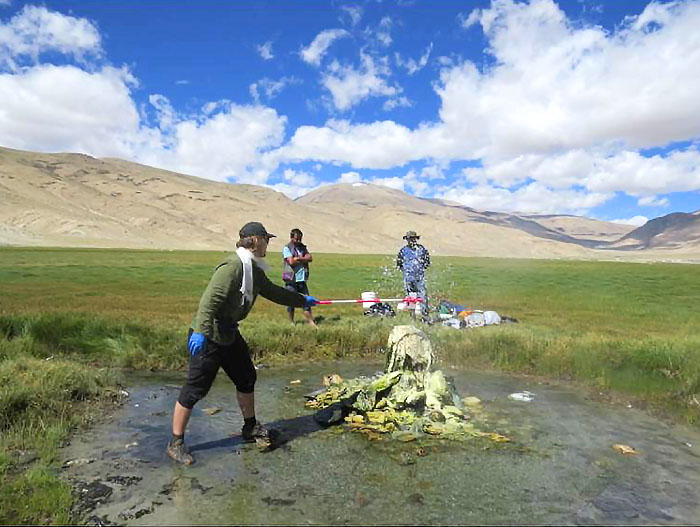
Figure 1. Luke Steller sampling active hot springs of the Puga Valley, India.
Boron has been found in high concentrations in some hot springs, perhaps most notably from the Puga Valley of India, in the mountains of the Himalaya. Excitingly, Boron has recently been found concentrated in hot spring deposits 3.5 billion years old, intimately associated with some of the oldest evidence of life on Earth.
In July, UNSW Honours student Luke Steller, funded by CCFS Flagship Program 4, participated in a Spaceward Bound trip to the Puga Valley to collect samples of boron-bearing hot spring deposits (boratic sinter, muds and hot spring fluids) for compositional and boron isotopic analyses at the Pheasant Memorial Laboratory of Okayama University in Misasa, Japan. The aim was to compare the isotopic composition of boron in the active boratic hotspring deposits with that of 3.5 billion-year-old deposits. To our delight, the boron-isotope results from Puga Valley hot spring fluids were exactly the same as those from the ancient deposits, at -13‰, whereas muds and silicic crusts were fractionated to much more negative values.
These results support our recent observations (see Research highlight p. 41) that the 3.5 billion-year-old stromatolites flourished in a boron-rich hot spring environment. They also lend support to models of the origin of life in hot springs, as not only Boron, but other critical elements for prebiotic chemistry (P, C, H, Zn, O, S) have been found concentrated in these ancient rocks.

This project is part of CCFS Theme 1, Early Earth, and contributes to understanding Fluid Fluxes.
Contacts: Martin Van Kranendonk, Luke Steller
Funded by: CCFS Flagship Program 4
Zircon trace elements reveal oxidation signatures in ancient mantle
A major problem in understanding magmatic processes in the modern Earth and its evolution since planetary accretion is evaluation of the oxidation states of magmas and their source regions. In this study, we thermodynamically and empirically calibrate a novel method for determining magmatic oxygen fugacity (ƒO2) in calc-alkalic, tholeiitic, adakitic and shoshonitic, metaluminous to moderately peraluminous and peralkaline melts as igneous zircon crystallised, to a precision of ±0.5 log unit ƒO2, using only the easily measureable, redox-sensitive ratios Ce/U and U/Ti in zircon (nominally ZrSiO4), without explicitly considering the ionic charge of Ce, U, or Ti, and without explicitly considering crystallisation temperature or pressure or silicate-melt composition (Fig. 1). Thermodynamic and empirical constraints indicate that our formulation is insensitive to variation of crystallisation temperature and pressure at lithospheric conditions. We use this new magmatic oxybarometer to illuminate the Hadean ‘dark ages’ (4.0-4.6 Ga), for which detrital zircons are the only surviving witnesses of the period during which the Earth’s proto-continental lithosphere developed.
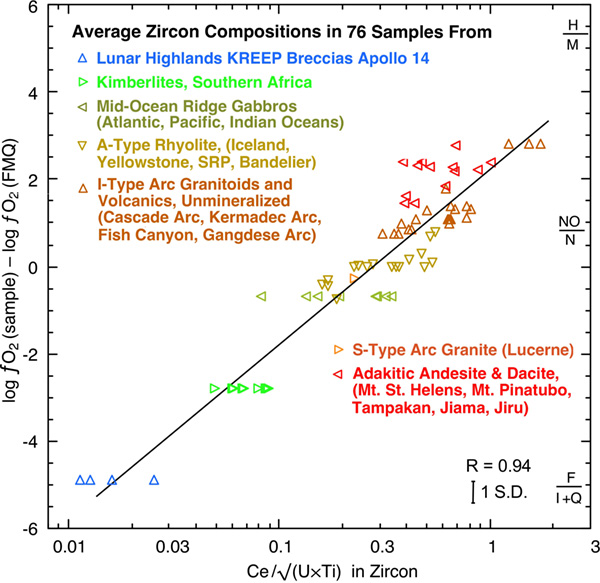
Figure 1. The average value of the parameter Ce/√(U×Ti) for the analysed zircon population in each rock sample is plotted against relative oxygen fugacity of the parent magma, as provided by independent constraints. The least-squares fit to the data (solid line) is ΔFMQ = 2.272 + 3.997 × log [Ce/√(U×Ti)], with a correlation coefficient R = 0.941 and a standard deviation of 0.495 log unit ƒO2. ‘SRP’ denotes Snake River Plain, Idaho. Lucerne granite is in Maine, USA. Bandelier Tuff is in the Rio Grande Rift, New Mexico (USA).
We identify the oxidation states of magmas that produced Hadean and Eoarchean zircons in the Yilgarn, South China, Slave and Wyoming cratons (Fig. 2). Zircons in the 4375-3800 Ma age range from the Yilgarn Craton cluster in the ƒO2 range of modern mid-ocean-ridge magmas, as do also most 3858-3200 Ma detrital zircons in the Wyoming Craton. More reducing conditions, about 2 log units lower ƒO2, are represented by 3970-3896 Ma zircons in the Wyoming Craton and all analysed Hadean igneous zircons (4121-4002 Ma) from the Cathaysia Block of the South China Craton and from the Acasta Gneiss Complex in the Slave Craton. These data indicate that the secular evolution of the oxidation state of our planet may have not been linear and globally homogeneous. Oxidised and reduced domains co-existed in the early stages of the Earth evolution. However, the presence of early reduced suites, such as the ones from the South China and Slave cratons, imply derivation of parental mafic magmas or of re-melted mafic protoliths from sub-continental lithospheric mantle domains strongly depleted in ferric iron by prior episodes of basaltic/komatiitic melt extraction. These data indicate that by 4 Ga there may have already been a localised build up of chemically refractory, buoyant harzburgitic lithospheric mantle keels that shielded the underside of proto-continental crust from ablative loss by asthenospheric mantle convection, thus creating the conditions for the long-lived preservations of cratons.

This project is part of CCFS Theme 1, Early Earth, and contributes to understanding Fluid Fluxes.
Contacts: Robert Loucks, Marco Fiorentini
Funded by: CCFS Flagship Program 2
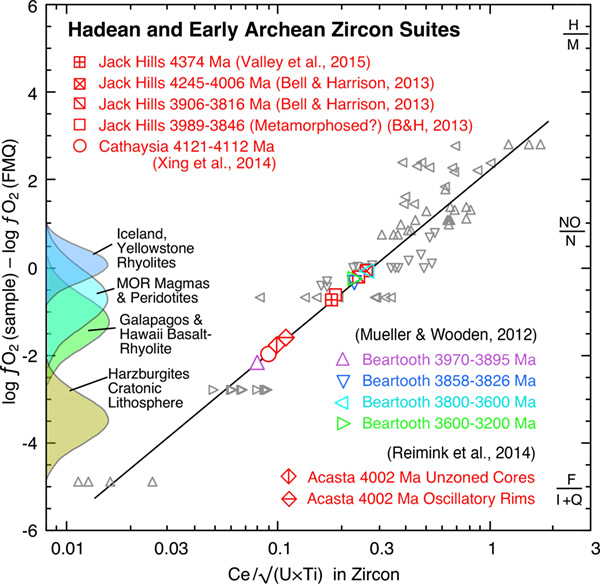
Figure 2. Average values of the parameter Ce/√(U×Ti) in suites of Hadean (4560-4000 Ma), Eoarchean (4000-3600 Ma), and Paleoarchean (3600-3200 Ma) zircons are plotted on the ƒO2 calibration line and dataset from Figure 2 in order to infer oxidation states of the parental magmas. Hadean and early Archean zircons are binned by locality and by age subgroups, within which each population is relatively homogeneous. The Jack Hills locality is in the Yilgarn craton, Western Australia; the Cathaysia block is in the South China composite craton; the Acasta gneiss complex is in the Slave craton, Canada; the Beartooth Mountains are in the Wyoming craton, USA. Grey symbols are reproduced from Figure 1 for ease of reference to mid-ocean-ridge and mantle-plume-related suites. Colored curves at left represent Gaussian frequency distributions of magmatic oxidation states in various tectonic settings, based on log ƒO2 data for mid-ocean ridge igneous suites and oceanic abyssal peridotites summarised from the literature.
Potassium-rich magmas from a phlogopite-free source

Potassium-rich lavas are generally assumed to be produced by melting of mantle rocks that contain phlogopite, which is the source of the potassium. In the Mediterranean region, trace-element and isotopic compositions indicate that continental crustal material must be involved in the generation of many potassium-rich lavas. Melting occurs here in young lithosphere that was newly formed during the collision of small blocks and oceans, meaning that the continental crust was not stored for a long period of time in the mantle.
Figure 1. Representative back-scattered electron images of reaction run 139 (1000 °C, 3 GPa). Grt: garnet; Opx: orthopyroxene; Cpx: clinopyroxene; M: melt; Coe: coesite.
Few experimental studies have investigated the reaction between melts of continental crust and depleted peridotites, and so the reactions and the redistribution of trace elements during hybridisation and melting processes remains poorly constrained.
We have compared two types of experiments investigating the reaction between crust and mantle at depths of 60-100 km. In the first, continental crustal metasediment (phyllite) and depleted peridotite were juxtaposed as separate blocks, whereas in the second, the same rocks were ground together as a homogeneous powder. In the first series, a clear reaction zone dominated by orthopyroxene was formed but no hybridised melt could be analysed, whereas in the second series, analysable pools of hybridised melt were produced. Melt compositions from both experimental series show high abundances of Rb (100-220 ppm) and Ba (400-870 ppm), and consistent ratios of Nb/Ta (10-12), Zr/Hf (34-42) and Rb/Cs (28-34) similar to bulk continental crust.
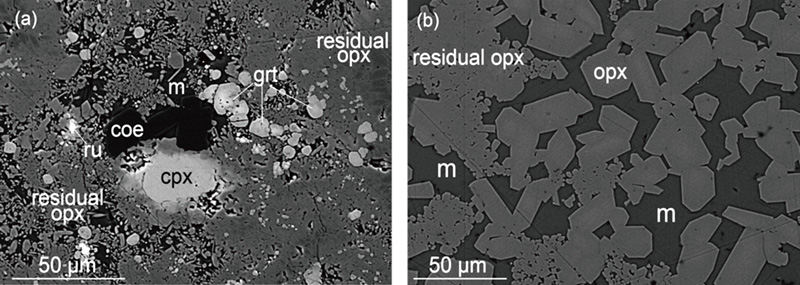
Figure 2. Representative back-scattered electron images of intimately mixed run products. Ru: rutile.
The hybridisation process produces melts with (Th/La)N of ~2.5, higher than melts from the sedimentary rock alone (~1.7), accentuating the high Th/La already produced by other processes. High Th/La is a characteristic of potassium-rich lavas in these post-collisional environments. Melting of sedimentary rocks can strongly fractionate Sr from Nd, whereas hybridised melts show much less fractionation because of the diluting effect of the peridotite.
The trace-element patterns of hybridised melts produced in our experiments are remarkably similar to post-collisional K-rich volcanic rocks. Almost all trace elements exhibit almost identical arrays to the post-collisional K-rich volcanic rocks but with slightly lower concentrations, which is probably due to the higher sediment:peridotite mass ratio (1:1) used in the experiments.
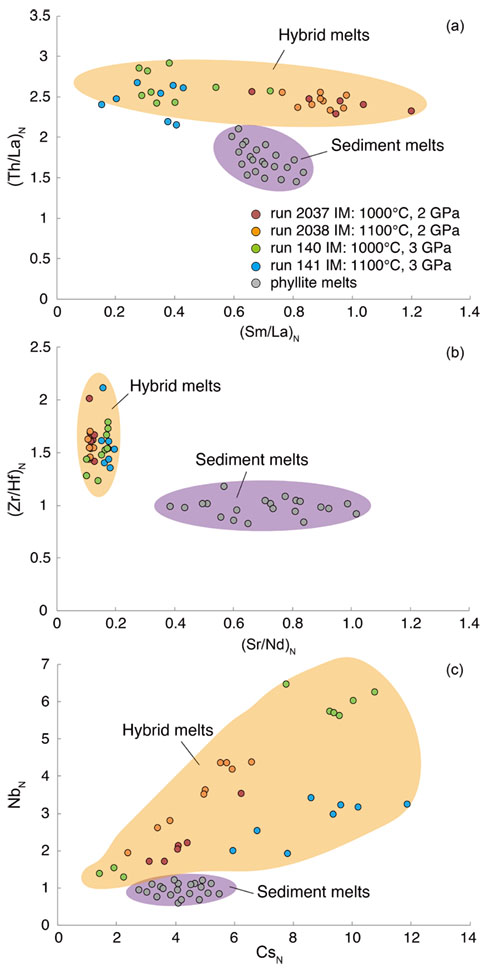
Figure 3. Variations of (a) (Sm/La)N versus (Th/La)N; (b) (Zr/Hf)N versus (Sr/Nd)N; (c) CsN (ppm) versus NbN (ppm) of the experimental melts. Subscript N denotes that the values have been normalised to their corresponding values in the starting materials in order to better reflect enrichment/depletion of key trace elements during melting in experimental runs. IM: intimately mixed runs.
A significant feature of our experimental results is the production of potassium-rich melts in the absence of residual K-rich minerals, which contrasts with most petrogenetic models that invoke phlogopite in the source of potassium-rich rocks. On the basis of previous experiments, phlogopite has been thought to form by interaction of melts with the mantle wedge due to slab-derived fluid/melt migration in the subduction zone.
Our study offers an alternative scenario that contradicts the widely held assumption that phlogopite is a required component in the source of potassium-rich magmas. Our experiments indicate that potassium may be exclusively incorporated in melts during hybridisation between sediment-derived melts and peridotite at shallow lithospheric depths. The potassium content of these melts (~4-5% K2O) is considerably enriched relative to that in the original phyllite (1.8 wt%) due to the breakdown of phengite in the phyllite, which is the only phase capable of providing a considerable amount of potassium to the whole-rock chemical inventory. The strongly peraluminous (A/(CNK) > 1.25) composition of the hybrid melts may indicate that a phlogopite-free source is most likely for peraluminous K-rich volcanic rocks.

This project is part of CCFS Themes 2 and 3, Earth’s Evolution and Earth Today, and contributes to understanding Earth’s Architecture and Fluid Fluxes.
Contacts: Yu Wang, Stephen Foley, Dejan Prelević
Funded by: CCFS Flagship Program 3, iMQRES scholarships, EPS postgraduate funds, Deutsche Forschungsgemeinschaft (DFG)

Figure 4. N-MORB normalised trace element compositions of hybridised melts in this study, compared to representative post-collisional K-rich volcanic rocks with K2O of 3-5 wt%.
An increase in the complexity of life across Earth’s Great Oxygenation Event
The Earth system fundamentally changed across the Archean-Proterozoic transition, not only the rate and mechanisms of crust formation, but also the composition of the atmosphere-hydrosphere. At about 2.4 Ga, the Great Oxygenation Event (or GOE), caused the irreversible oxygenation of Earth’s atmosphere, producing a significant change in a variety of rock types and ore deposits. In addition, this first (but probably not last!), global pollution of the atmosphere by living organisms had a profound impact on life, resulting in the rise of eukaryotic life, with complex cell structures, and the adaptation of prokaryotic life (bacteria) to the new environmental conditions.
Perhaps the best (and only?) place to directly witness the adaptation of life across the GOE is in the Turee Creek Group of Western Australia. Here, a 350 m thick unit of stromatolitic shallow-water carbonate and microfossil-bearing deep-water black chert that was deposited in the immediate aftermath of the GOE contains a variety of evidence for a dramatic increase in the complexity of life. This includes a host of never-before described microfossils from a benthic, deep water, non-phototrophic, community. Previously documented forms are relatively large and filamentous, while the new microfossils include spherical aggregates of cells preserved in ultrafine-grained silica, and very fine filamentous forms that rim other microfossils and degraded organic material and appear to be organotrophs (organisms that harvest hydrogen or electrons from organic substrates).
In the shallow-water carbonate setting, stromatolites display a dramatic increase in morphological variation and complexity compared with any Archean example. This is the first appearance of complex branching forms, and the first occurrence of thick units of clot textured microbialites interbedded with stromatolites. This texture appears to have arisen when floating microbial communities suspended in the water column fell to the seafloor and were quickly cemented in place by coarse, radiating dolomite.
But perhaps the most exciting discovery is the small (up to 1 cm long), hollow, tube-like structures that surround finger-size columnar stromatolites in a unit 15 cm thick. The tube-like structures surround the stromatolites and are attached to them. They have thick, kerogen-rich rims, and hollow cores now filled by fine-grained silica (microquartz), carbonate, and an inner necklace of tiny framboids of highly fractionated (δ34S = +22 ‰) pyrite. These structures most closely resemble primitive calcareous sponges, although a eukaryotic origin has not been proven. Further work - funded by CCFS in 2017 - will investigate the kerogen in an attempt to document what may be the world’s oldest eukaryote. See CCFS Publication #697 Barlow et al., Geobiology, 4, 317-343.

This project is part of CCFS Theme 1, Early Earth, and contributes to understanding Fluid Fluxes.
Contacts: Erica Barlow, Georgia Soares, Brendan Nomchong, Martin Van Kranendonk
Funded by: CCFS Flagship Program 4
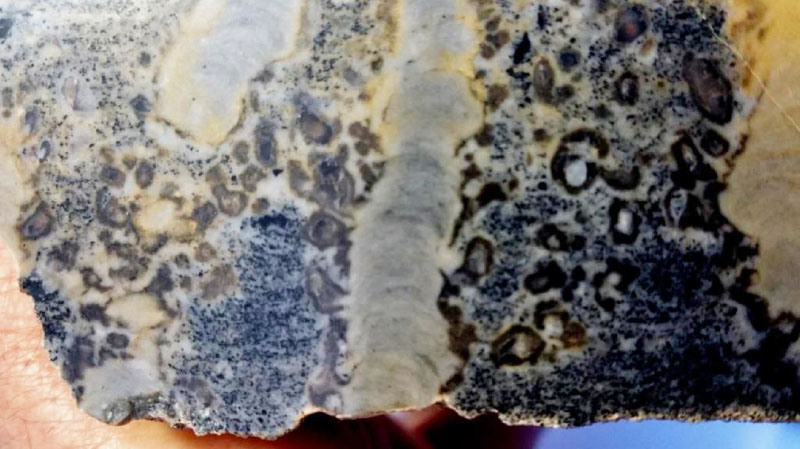
Figure 1. Cut sample showing cross-section view of the hollow tube-like structures (dark grey-brown) attached to the sides of small (finger-size) columnar stromatolites (light grey, with convex lamination).
What is the real S isotope composition of Earth’s mantle?
Sulfur isotopes are a powerful geochemical tracer in high-temperature processes, but have rarely been applied to the study of the source and composition of fluids in the deep Earth. The only S-isotope data from the sub-continental lithospheric mantle (SCLM) for the mantle beneath cratons, the most ancient regions of Earth’s continents, are from sulfide inclusions in diamonds. To provide new constraints on the S isotope composition of the SCLM and on the source(s) of mantle metasomatic fluids beneath the diamondiferous Kimberley region (South Africa), a research team led by ARC DECRA Fellow Andrea Giuliani and ARC Future Fellow Marco Fiorentini investigated the S isotope systematics of metasomatised (i.e. fluid-enriched) mantle xenoliths (i.e. fragments) transported to surface by the Bultfontein kimberlite (Kimberley, South Africa).

Figure 1. Photo- micrographs of sulfide aggregate in Bultfontein mantle xenolith.
Different types of sulfides (pentlandite and chalcopyrite) in these xenoliths were analysed by in situ secondary-ion mass spectrometry (SIMS), while bulk-rock material was analysed by gas source isotope ratio mass spectrometry techniques. Previous studies have shown that these xenoliths experienced different types of metasomatism at distinct times (~180 and ~90-80 Ma). Pentlandite grains are variably altered to heazlewoodite (Ni sulfide) + magnetite. The in situ S isotope analyses of pentlandite exhibit a relatively restricted range between -5.9 and -1.4‰ δ34S (compared to VCDT), with no statistically meaningful differences between samples. Chalcopyrite only occurs in one sample and also shows δ34S values between -5.4 and -1.0‰. The bulk-rock Ssulfide isotope analyses vary between -3.4 and +0.8‰ δ34S. Importantly, the only sample hosting dominantly fresh sulfides shows a bulk-rock δ34S value consistent with the mean value for the sulfides, whereas the other samples exhibit higher bulk 34S/32S ratios (i.e. higher δ34S values). The differences between bulk-rock and average in situ δ34S values are directly correlated with the degree of alteration of the sulfides. This indicates that the high 34S/32S ratios in the bulk samples are not due to the introduction of heavy S (commonly as sulfates) and are best explained by isotopic fractionation driven by the removal of light S during serpentinisation, when pentlandite is altered to S-poor mixtures of heazlewoodite and magnetite. Available bulk Ssulfide isotopic data for SCLM peridotite xenoliths are dominated by positive δ34S values, which contrasts with the negative values of the sulfides reported in this and previous studies. These results imply that the mantle S isotope values from bulk peridotite samples are commonly modified by isotopic fractionation during serpentinisation. Therefore, the S isotopic composition of the SCLM may require revision.

Figure 2. SEM-EDS image of sulfide grain in sample XM1/345 from Bultfontein showing δ34S variations (as ‰ units) measured by SIMS. Values reported in yellow represent mixtures of pentlandite and heazlewoodite and are not considered quantitative because the instrumental fractionation factor for heazlewoodite is unknown. (Mgt: magnetite; Hz: heazlewoodite)
The limited isotopic variability shown by sulfides in the Bultfontein mantle xenoliths is probably due to intermittent tapping of fluids from a mantle source with a relatively restricted S isotope composition. While the asthenospheric mantle (δ34S ≤ -1.4‰; Labidi et al., 2013 Nature, 501, 208-211) is one candidate, δ34S values as low as -5.9‰ suggest input from recycled crustal material in the mantle. This recycled material could be represented by the sulfur reservoir with negative δ34S that is missing in the >500 Ma sedimentary record (Canfield, 2004, American Journal of Science, 304: 839-861), which was subducted and mixed with ambient material in the Earth’s deep interiors. This study highlights the importance of S isotope geochemistry to trace the source of fluids in the mantle. See CCFS publication # 789 Giuliani A., Fiorentini M.L., et al., Earth and Planetary Science Letters, 445, 114-124.

This project is part of CCFS Theme 2, Earth’s Evolution, and contributes to understanding Fluid Fluxes.
Contacts: Andrea Giuliani, Marco Fiorentini
Funded by: ARC DECRA, ARC Future Fellowship
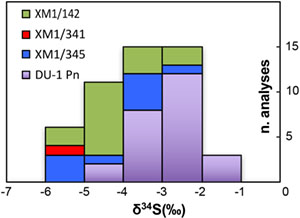
Figure 3. In situ sulfur isotope (‰ δ34S relative to VCDT) analyses of pentlandite grains in Bultfontein mantle xenoliths. Different colors are used for each xenolith sample.
Zircon - a pathfinder for porphyry Cu ± Mo ± Au deposits
Porphyry Cu (±Mo ±Au) deposits supply nearly ~70% of the world’s Cu, ~50% of its Mo, and ~25% of its Au. This type of mineral deposit mainly occurs in the circum-Pacific and Alpine-Himalayan mountain belts (Fig. 1). Discovery of new deposits is costly and challenging, and industry urgently needs tools for chemical fingerprinting or fertility assessment of potential exploration targets.
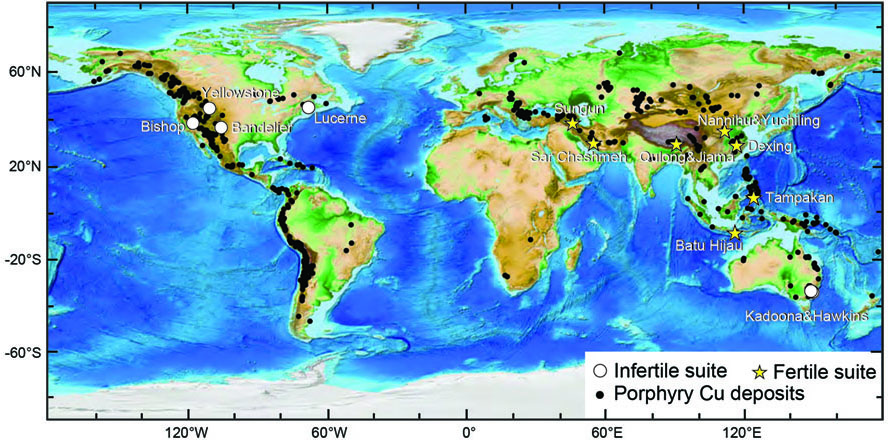
Figure 1. Map showing the worldwide distribution of porphyry Cu deposits, and the fertile and infertile magmatic suites investigated in this study.
Zircon (ZrSiO4) is ubiquitous in Cu-ore-forming magmatic suites and records the compositional evolution and varying conditions of the parent melt. Zircon also survives intense hydrothermal alteration and weathering and long-distance detrital transport. It is now economically feasible to do rapid, precise characterisation of the chemistry of detrital zircons by Laser Ablation Inductively Coupled Plasma Mass Spectrometry (LA-ICPMS) to see whether a watershed contains eroding igneous rocks that might carry Cu ± Mo ± Au deposits.
We have investigated integrated LA-ICPMS U-Pb dating and trace-element analysis of zircon from infertile and fertile magmatic suites to see if there is a distinct zircon chemistry diagnostic of ore fertility of the parent magma (Fig. 1). The infertile suites are defined as magmatic rocks that have no mineralisation at any grade, whereas fertile suites refer to the intrusions related to porphyry-type ore deposits. The infertile suites are relatively reduced S- and A-type and relatively dry A- and I-type magmas, including the Yellowstone rhyolite (Wyoming), Bandelier rhyolite (New Mexico), Bishop tuff rhyolite (California), Lucerne reduced granite (Maine), and Hawkins S-type dacite and Kadoona I-type dacite (Lachlan belt, Australia). The fertile suites are more oxidised and hydrous and are selected from representative I-type intrusions related to porphyry and high-sulfidation epithermal Cu-Au deposits (Batu Hijau, Indonesia and Tampakan, Philippines), porphyry Cu-Mo-Au deposits (Sar Cheshmeh, Iran, Dexing, eastern China and Jiama, southern Tibet), porphyry Cu-Mo deposits (Sungun, Iran, and Qulong, southern Tibet), and porphyry Mo deposits (Nannihu and Yuchiling, central China).
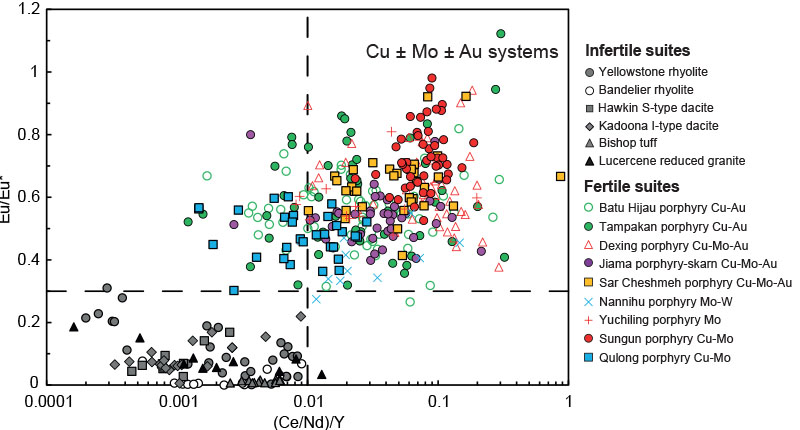
Figure 2. Zircon Eu/Eu* versus (Ce/Nd)/Y plot. Eu/Eu* is europium anomaly, calculated as [Eu]/sqrt([Sm]*[Gd]) using concentrations already normalised to chondrite. Fertile suites have distinctly higher zircon Eu/Eu* values (>0.3) and (Ce/Nd)/Y ratios (>0.01) than infertile magmatic suites due to high magmatic water contents in the ore fertile suites.
The best fertility indicators are zircon Eu/Eu* and (Eu/Eu*)/Y ratios (Figs. 2 and 3). In particular, zircons from fertile magmatic suites have collectively higher zircon Eu/Eu* ratios (>0.3), 10,000*(Eu/Eu*)/Y (>1), and (Ce/Nd)/Y (>0.01) ratios than infertile suites. In fertile suites, zircon (Eu/Eu*)/Y ratios are positively correlated with (Ce/Nd)/Y ratios, but this correlation is absent in the infertile suites. These distinct trace element ratios are interpreted to indicate a specific differentiation trend (suppression of plagioclase fractionation and enhanced early amphibole fractionation), the result of high magmatic water contents, which are a prerequisite for magmatic-hydrothermal (porphyry) ore formation. These zircon trace element ratios can identify magmatic suites that are potentially fertile for porphyry Cu-Au, porphyry Cu-Mo-Au, porphyry Cu-Mo, and porphyry Mo (-W) systems.
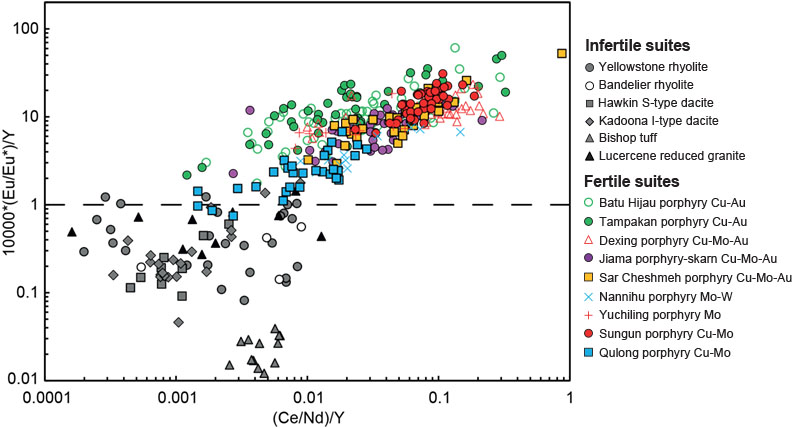
Figure 3. Zircon 10,000*(Eu/Eu*)/Y versus (Ce/Nd)/Y plot. Fertile suites have distinctly higher zircon 10,000*(Eu/Eu*)/Y ratios (>1) and (Ce/Nd)/Y ratios (>0.01) than infertile magmatic suites due to high magmatic water contents in the ore fertile suites. See legend, Figure 2.
Combining all these zircon fertility indicators, it is possible to screen terranes or arc segments and distinguish those with unprospective A-, S-, and I-type granitoids from those with potentially mineralising I-type granitoids. Analysing detrital zircons from an area with little geologic information or poor outcrop could efficiently and cheaply identify drainages dominated by fertile I-type granitoids, so exploration could be focused on the most prospective areas.

This project is part of CCFS Themes 2 and 3, Earth’s Evolution and Earth Today, and contributes to understanding Fluid Fluxes.
Contacts: Yongjun Lu, Robert Loucks, Marco Fiorentini, Cam McCuaig, Chris Kirkland, Luis Parra-Avila
Funded by: CCFS Flagship Program 2; CCFS Tibet pilot project
The giant sudoku of early Earth - a new solution?
The 2.0 - 1.8 Ga time interval in Earth’s history is marked by globally widespread orogeny. These events accompanied the assembly of previously dispersed microcontinents and formed large cratons such as Laurentia (the cratonic part of North America), Baltica (East Europe), Siberia, Australia and Kalahari, and the accretionary growth of others (e.g. Amazonia). Most of these and other protocontinents then collided to form the Paleo-Mesoproterozoic supercontinent Nuna. The timing of the final assembly of Nuna is still debated, but broadly considered to be between 2.0 and 1.6 Ga.

Figure 1. Geological map of the Onego Lake area.
Two key members of Nuna - Laurentia and Baltica, are proven to be mainly assembled and remained together between 1700 and 1270 Ma. Paleomagnetic data clearly indicate that Fennoscandia (the northern part of Baltica) joined Laurentia at about 1775 Ma, but the details of assemblies and eventual collision of these key members is still unclear. Our new 1975 Ma paleomagnetic data from Russian Karelia, together with previously published coeval paleopoles from Superior and Slave cratons (building blocks of Laurentia) throw some new light on this story. This study was done in collaboration with Natalia Lubnina (Moscow State University), Alexandra Stepanova and Svetoslav Sokolov (Karelian Research Center), and Svetlana Bogdanova (Lund University).
We studied well-dated 1785-1770 Ma mafic dykes and sills near the coast and on the islands of the Onego Lake in Russian Karelia (Figs. 1 and 2). Our study revealed a stable primary paleomagnetic remanence supported by several robust contact tests. Based on our new 1975 Ma Fennoscandian key paleopole and published poles from other cratons, we propose a paleomagnetically and geologically allowable 1975 Ma paleogeographic reconstruction of the Karelia (pre-Svecofennian Fennoscandia), Superior, Slave, Rae, Hearne and Amazonia cratons (Fig. 3). We conclude that at 1975 Ma all these cratons were widely separated by proto-oceans.
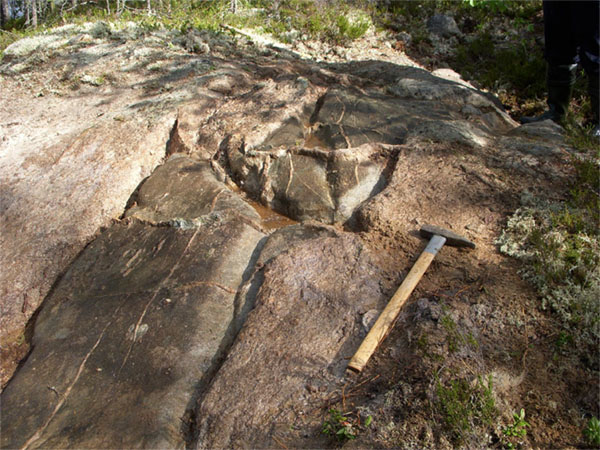
Figure 2. 1975 Ma mafic dyke.
In particular, the Karelia, Superior and Slave cratons were located at significantly different paleolatitudes, and their mutual azimuthal orientations require significant rotations before their final assembly at 1775 Ma (Fig. 3). This implies that the amalgamation of the Paleo-Mesoproterozoic supercontinent Nuna probably started after 1975 Ma. See CCFS publications #309, 882.

This project is part of CCFS Themes 2 and 3, Earth’s Evolution and Earth Today, and contributes to understanding Earth’s Architecture.
Contacts: Sergei Pisarevsky
Funded by: CCFS Flagship Program 5
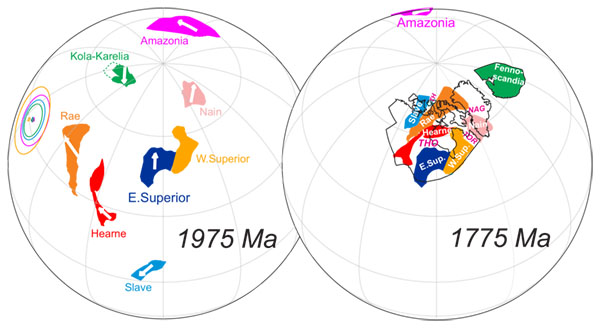
Figure 3. Paleogeographic reconstructions at 1975 Ma and 1775 Ma in Laurentian coordinates. 1.9-1.8 Ga orogens: THO - Trans-Hudson; 427 TOR - Torngat; NAG - Nagssugtoqidian; TH - Thelon.
Diamond formation caught in flagrante delicto
Gem-sized diamonds record a long history of growth and dissolution, resulting in complex zonation patterns that can be visualised by cathodoluminescence imaging. In contrast, polycrystalline diamonds form very rapidly, presenting snapshots of extreme conditions of diamond formation that complement our more time-integrated perspective of diamond growth derived from slowly grown gem-sized diamonds.
Polycrystalline diamonds are aggregates of diamond crystals with heterogeneous grain sizes and random orientation. They are found together with gem-sized diamonds in kimberlites in Africa and Siberia and can locally amount to ca 20% of the total diamond production.

Figure 1. Overview of the iron sulfides included in diamond. A 150 nanometre thin foil cut by focused ion beam milling shows the host diamond with two iron sulfide inclusions connected by a veinlet of iron sulfide. The foil is covered by a protective Platinum strip (bottom) and displays some gallium residue from milling. Scale bar is 2µm.
The diamond aggregates can have up to 30% porosity, indicating they formed from a volatile-rich medium strongly oversaturated in carbon. Evidence from this diamond species emphasises the importance of redox gradients for the formation of diamond in the Earth’s mantle. Recently we had the opportunity to study a sample from the Orapa Mine in Botswana using a novel microanalytical method called Transmission Kikuchi Diffraction. This method allows analysis of the structural and crystal orientation of mineral grains as small as some tens of nanometres (one nanometre is one billionth of a metre). It was the first time this method, developed in the material sciences, was applied to a natural rock sample.
A 150 nanometre thin foil, cut from the sample by Focused Ion Beam milling, transected one of the diamond crystals and the minerals included in that crystal (Fig.1). These inclusions were two iron sulfide crystals, one of which was rimmed by tiny grains of iron oxide (magnetite, Fig. 2). Iron oxide also occurred as larger grains in other parts of this sample, but its association with iron sulfide was only revealed in this area.
Our Transmission Kikuchi Diffraction analyses showed that the crystal lattices of all three minerals, diamond host, iron oxide rim and iron sulfide grain, were systematically aligned. This phenomenon, termed epitaxy, is evidence that during their formation, each of the minerals nucleated and grew on the surface of the other. This is the first time the phenomenon has been documented in a diamond sample from the Earth’s mantle and reveals that the trigger for the growth of the diamond lies in the redox (reduction-oxidation) reaction of carbonate (in a fluid) with iron sulfide to form iron oxide and diamond.
The most effective redox couple in the Earth’s mantle is carbon and iron, which controls the onset of carbonate melting at depth by reduction of Fe3+ and oxidation of graphite or diamond. Conversely, oxidation of Fe2+ may lead to the freezing of mobile carbon species in the form of graphite or diamond. Iron (Fe2+) sulfides in the Earth’s mantle thus represent a reservoir with considerable redox potential. While sulfide is generally rare in the mantle, billions of years of subduction have created patches highly enriched in crustal material that contain abundant sulfides, carbon and volatiles and provide a very reactive environment in the Earth’s mantle. One of these rarer patches seems to have been sampled by the kimberlites of the Orapa diamond mine.
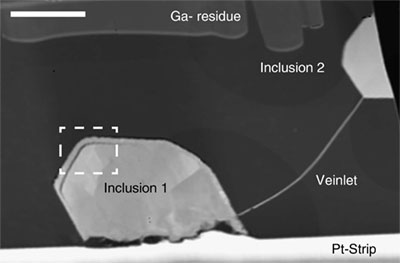
Figure 2. Crystallographic analysis of the iron oxide corona. Forescatter electron image of the iron oxide corona. Note that most of the iron sulfide was lost during re-thinning. The crystallography of areas I, II and III was further analysed. Scale bar is 0.5 µm.
Further investigation of the iron oxide grains rimming the iron sulfide could pin down the depth of this diamond-forming reaction to the base of the lithospheric root of the Kaapvaal craton (~180 km depth), because the grains preserve a ‘memory’ of a phase transformation from a high-pressure modification of iron oxide.
Another important result from the use of the Transmission Kikuchi Diffraction method is that the iron sulfide grains were mechanically deformed, while the diamond hosting these inclusions was undeformed. This can only be explained if the iron sulfide grains were already crystallised and solid when the diamond included them, rather than liquid melt droplets. It appears therefore that pre-existing iron sulfide grains reacted with a carbonate-rich fluid or melt to form both a thin rim of iron oxide around the iron sulfides, and the enclosing diamond.
Unravelling the ages of diamonds relies entirely on the assumption that the inclusions in them, which are used for radiogenic isotope dating, are syngenetic to the diamond host. Our observations show that the iron sulfides predate the diamond and it is unclear how much time lies between the formation of the two minerals. This finding raises questions about some widely accepted concepts that need to be addressed in the future. See CCFS publication #716, Jacob et al., Nature, 7, 11891, 2016.

This project is part of CCFS Theme 2, Earth’s Evolution and contributes to understanding Fluid Fluxes.
Contacts: Dorrit Jacob
Funded by: CCFS Pilot Project “Diamond growth at the nanoscale - Mantle fluids at work”
Birdshot on Mt Carmel: Immiscible metal, metal-oxide and silicate melts
Aggregates of hopper-formed corundum crystals (Carmel Sapphire) are common in Cretaceous pyroclastic ejecta exposed on Mt Carmel (Israel). Melt pockets trapped within and between corundum crystals contain mineral assemblages (SiC (moissanite), Fe-Ti-Zr silicides/phosphides, native V) that require high T and extremely low ƒO2 (IW -10). Paragenetic studies suggest that the corundum and low ƒO2 reflect interaction of mafic magmas with mantle-derived (CH4+H2) at high fluid/melt ratios, leading to progressive reduction and desilication of the magma, and ultimately to Al2O3-supersaturation, the rapid growth of corundum, and the deposition of abundant amorphous carbon. This evolution included several stages of liquid-liquid immiscibility.

Figure 1. (a) Fe ball surrounded by shell of FeO-rich oxide melt; attached smaller balls are FeO-rich and TiO-rich melts with vesicles. (b) EDS image of Fe distribution at contact, showing dendritic crystals of FeO in a silicate-rich matrix (dark).
Spherical to drop-shaped metal-rich pellets from <100 µm to several mm in diameter are common in the pyroclastics, and appear to be melts separated from basaltic magma. They comprise Fe alloys, two types of metal-oxide melts, and a Fe-K-rich silicate melt. Pellets of different types and sizes may be stuck together (Fig. 1), suggesting the collision of melt droplets. Most pellets are vesicular, and in many a large central void makes up most of the drop. These structures suggest that the initial melts contained high levels of volatiles (type unknown) that exsolved as the melts cooled, and were trapped inside the solidified outer shell. Four general types can be identified.
1. Fe melts: Generally ca 90% Fe, but some contain much higher Mn, Cr and Ni. Many contain micro-inclusions of type (2) below; they are typically rimmed by types (2-4) (Fig. 1, 4).
2. Fe-oxide melts: Example: SiO2 6%, TiO2 2%, Al2O3 2%, MgO 1%, FeO 87%, CaO 1.5 %. These typically consist of skeletal crystals of stoichiometric FeO (at % Fe= 50-55%), in a matrix enriched in Si, Al, Mg and Ca, apparently glassy; they commonly have a core of type 1 (Fig. 2).
3. Ti-oxide melts: Either very fine-grained, with internal bands suggestive of Liesegang rings (Fig. 3a) or quenched to long blades of FeTi2O5 in a matrix enriched in Si and Ca (Fig. 3b).
4. Iron-rich silicate glass: Extremely vesicular (Fig. 4), heterogeneous with Liesegang-ring zoning around vesicles and balls of types 1-3. Mean composition SiO2 40%, TiO2 1%, FeO 30%, MnO 11%, Na2O 2%, K2O 14%.
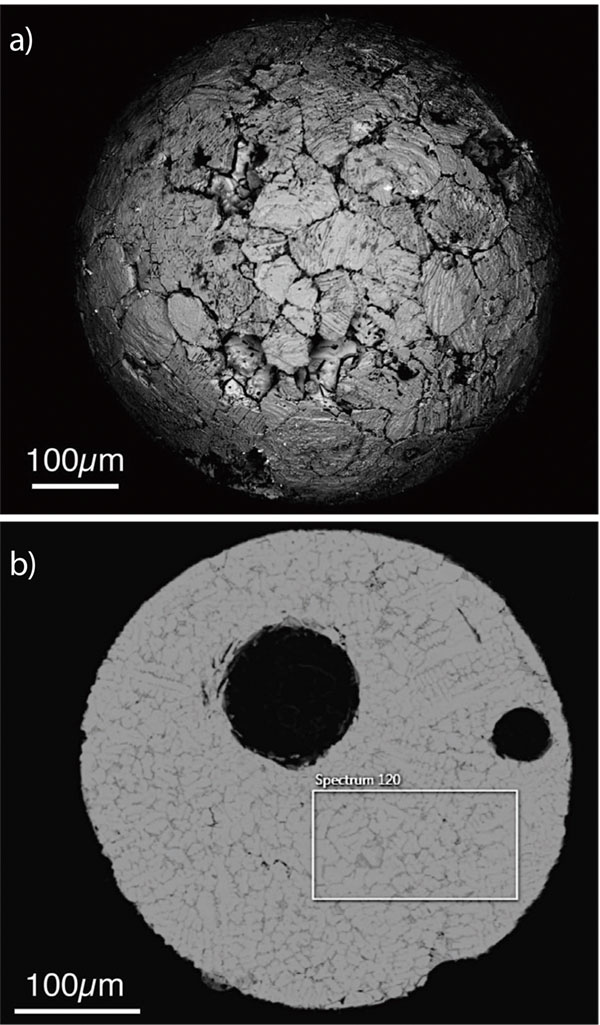
Figure 2. FeO-rich ball (a) surface showing plates made up of FeO crystals in matrix of glass richer in Si, Al, Ca; (b) polished section showing vescicles, and dendritic crystals of FeO in silicate-rich matrix.
We suggest that these pellets were formed when ƒO2 dropped to the Iron-Wustite boundary, resulting in the separation of mutually immiscible melts from the host magma. The vesicular nature of the oxide balls, coupled with the other data on the corundum system, suggests that mantle-derived methane (±H2) provided both the reducing power, and the abundant gasses, through reactions such as 4FeO (melt) + CH4 → 4Fe + CO2 +2H2O and Fe2O3 + CH4 → 2FeO +CO2 +H2O. This immiscibility played an important role in the further development of the Mt Carmel magmatic system toward final desilication and super-reduction: none of the silicate or oxide phases in the corundum aggregates contain Fe, because most of it had been removed earlier.
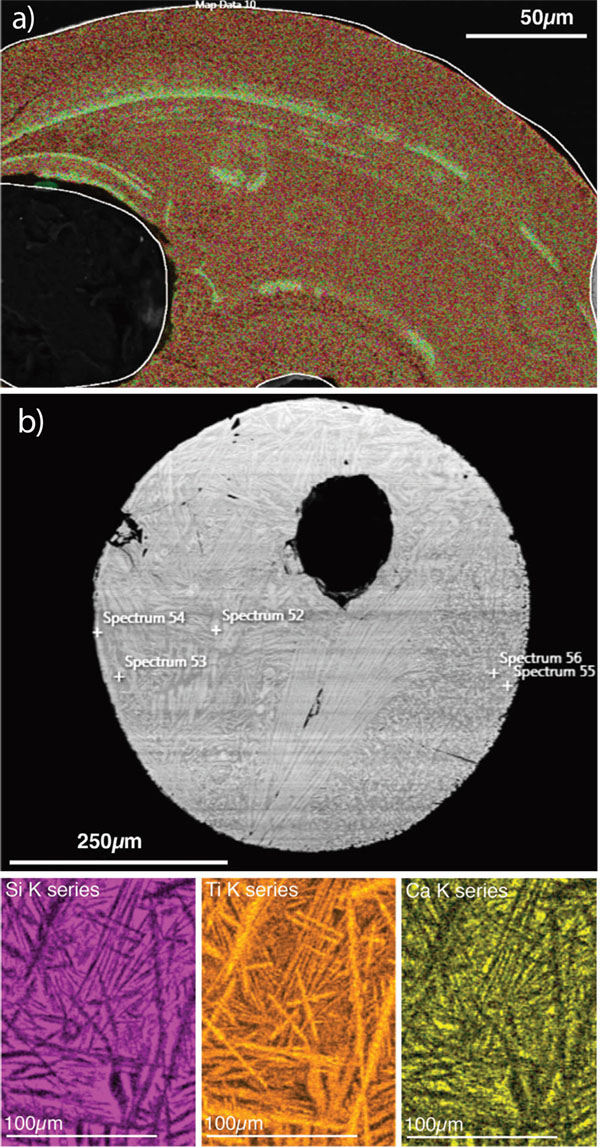
Figure 3. TiO-rich balls (a) EDS phase map of fine-grained ball, showing Liesegang-type zoning around vescicles. Light bands are rich in Ca and W. (b) TiO-rich ball with radiating crystals of FeTi2O5 (ferro-pseudobrookite) in Si-Ca-rich matrix.
A similar model has been proposed by Grebnikov et al. (2012; J. Volcanol. Seismol. 6, 211-229) to explain Fe-cored Fe-oxide balls (our type 2) in Yakutian ignimbrites.

This project is part of CCFS Theme 2, Earth’s Evolution and contributes to understanding Earth’s Architecture and Fluid Fluxes.
Contacts: Bill Griffin, Sue O’Reilly, Jin-Xiang Huang, Sarah Gain
Funded by: CCFS Flagship Program 1 (TARDIS II)
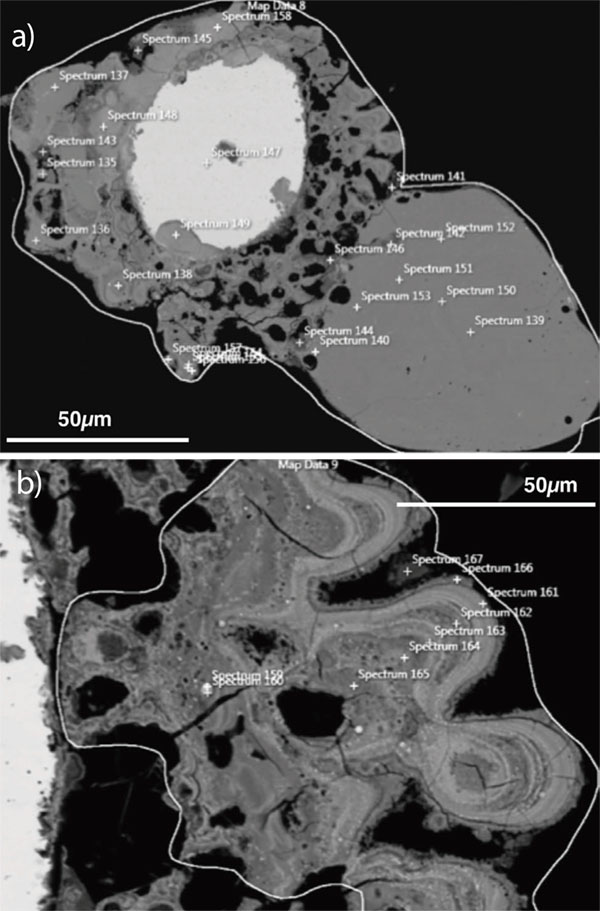
Figure 4. Silicate-metal-oxide melts. (a) BSE image, Fe ball surrounded by vesicular Fe-Mn-Si-K glass; attached ball is TiO-rich type 2. (b) Closeup of silicate glass, showing zoning around vesicles. Lighter bands are richer in Fe+Mn, lower in Si+K.
Sulfur-loving elements in meteorites from Mars probe the extra-terrestrial mantle?
The Martian mantle is not available for direct sampling, but shergottite meteorites are thought to be derived from Mars; they can provide information on the chemical/petrological properties of Martian mantle reservoirs and igneous rocks. Whole-rock analysis of shergottites for Se and Te, as well as the highly siderophile elements (HSE) Au, Re, and PGE (Os, Ir, Ru, Rh, Pt, and Pd), led to the hypothesis that these elements were stripped from a magma ocean by Fe-Ni liquids at intermediate mantle pressures (~14 GPa).
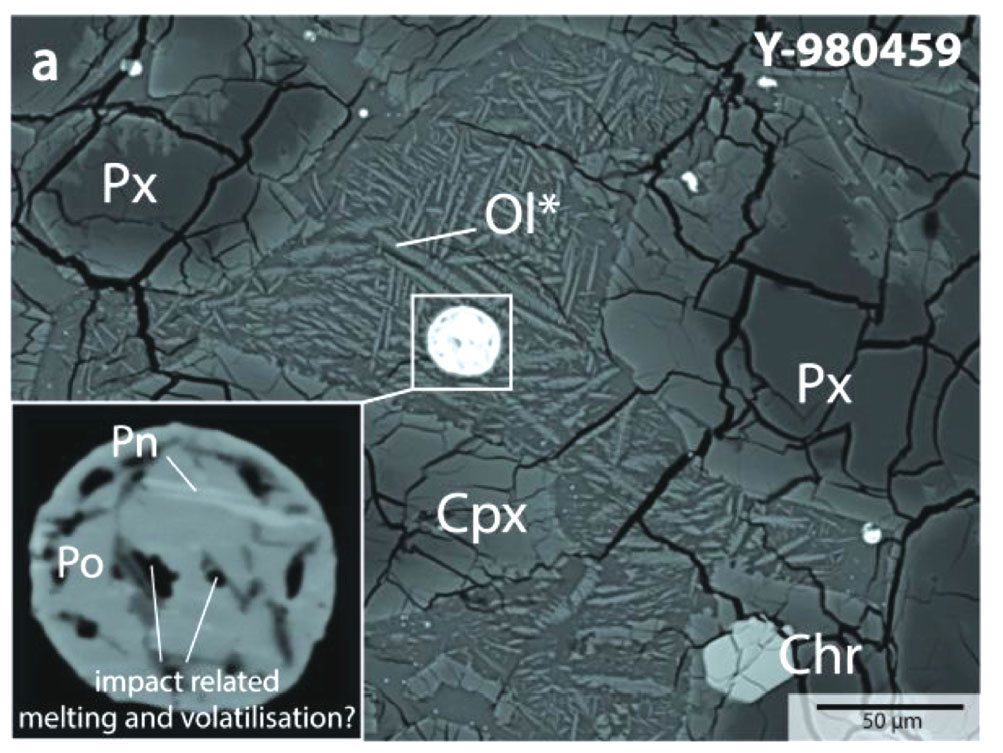
Figure 1. BSE image of a blebby (quench) sulfide assemblage in the fine-grained and plagioclase-free silicate mesostasis of Y-980459. Cpx = clinopyroxene, Chr = chromite, Ol* = dendritic olivine, Po = pyrrhotite, Px = pyroxene.
Selenium, Te and HSE behave as chalcophile elements at redox conditions outside the stability field Fe-Ni metal. Hence, in Mars’ mantle and derived magmas, sulfides may exert a major control on these elements, while PGE may also form discrete minerals (e.g. platinum group-minerals, PGM). However, the magmatic Fe-Ni-Cu sulfides contained in shergottites were not yet analysed by high-precision techniques, and no PGM were observed to date. Therefore, we acquired the first LA-ICPMS trace-element analyses on sulfides from selected high-Mg# olivine-phyric shergottites depleted in incompatible trace elements (ITE-depleted; Y-980459, DaG 476 and Dhofar 019), and one ITE-enriched, low-Mg# basaltic shergottite (Zagami).
The shergottite sulfides generally occur in spherical to ellipsoidal, and/or multiply lobed droplets usually ≤50 μm in size. Their pyrrhotite-dominated mineralogy (Fig. 1) is consistent with their in situ crystallisation from Ni- and Cu-poor immiscible sulfide melts, in which exsolution of Cu-sulfide and pentlandite was largely suppressed. However, magmatic characteristics have been variably masked by alteration on both Mars and Earth, as well as impact-related sulfide volatilisation during meteorite ejection. The small grain sizes and complex sulfide exsolution textures mean that individual sulfide phases cannot be resolved (Fig. 1), so the LA-ICPMS analyses represent the composition of the bulk sulfide.

Figure 2. Chondrite-normalised concentration patterns for median PGE values in sulfides from DaG476 (a) and Zagami (b), compared to whole-rock data reported in Brandon et al. (Geochim. Cosmochim. Acta, 2012). The sulfide median and 25th/75th percentile values have been calculated from 22 and 35 single sulfide analyses from DaG 476 and Zagami. In order to improve data comparison, the whole-rock data are recalculated to the chondrite-normalised mean Pd concentrations in sulfides. The main deviations from the trends in whole-rock data are the Pt- (and Ir-?) deficiencies in sulfides, specifically in Zagami where no sulfide was found to contain Pt above detection limit.
The sulfide PGE-signatures mimic available whole-rock analyses, with Cl-normalised patterns that increase in steepness with decreasing whole-rock Mg#, a signature of magmatic differentiation (Fig. 2a and Fig. 2b). While these variations suggest major sulfide controls, the Pt-depletions in sulfides may relate to the predominance of (nano-scale) Pt-Fe alloys in FeO-rich and reduced Martian magmas. Positive correlations exist between total Se, Te and HSE (particularly Pd) in sulfides, and whole-rock Mg# in the order Y-980459 >DAG 476 >Dhofar 019 (Fig. 3a). Notably, these trends are even preserved following recalculation to whole-rock concentrations on the basis of bulk sulfur analyses (Fig. 3b).
These results provide insights on siderophile-chalcophile element transfer in FeO-rich shergottite magmas. No whole-rock Te data exist to date, and previous whole-rock HSE concentrations have been questioned because of analytical issues (i.e., nugget effect) in the bulk-rock analyses of small sample masses. However, our data resolve distinct differences in PGE (particularly Pd) between the respective shergottites (Fig. 3b). Hence, provided that the analysed olivine-phyric shergottites relate to comparable mantle/magma sources, the positive correlations between Mg#, Se, Te and Pd may relate to sulfide immiscibility and fractionation during mantle melting, magma ascent or crystallisation.
In summary, our pilot study provides new insights into the behaviours of chalcogens and highly-siderophile elements in Martian magmas. More in situ analyses on sulfides from shergottite specimens may show whether the observed variations in sulfides are a general trend among (ITE-enriched and -depleted) olivine-phyric and basaltic shergottites, and if any such differences may lead to the more detailed understanding of sulfide stability and siderophile-chalcophile element transfer in igneous systems on both Mars and Earth.

This project is part of CCFS Themes 1 and 2, Early Earth and Earth’s Evolution, and contributes to understanding Fluid Fluxes.
Contacts: Raphael Baumgartner, Marco Fiorentini
Funded by: CCFS Flagship Program 2
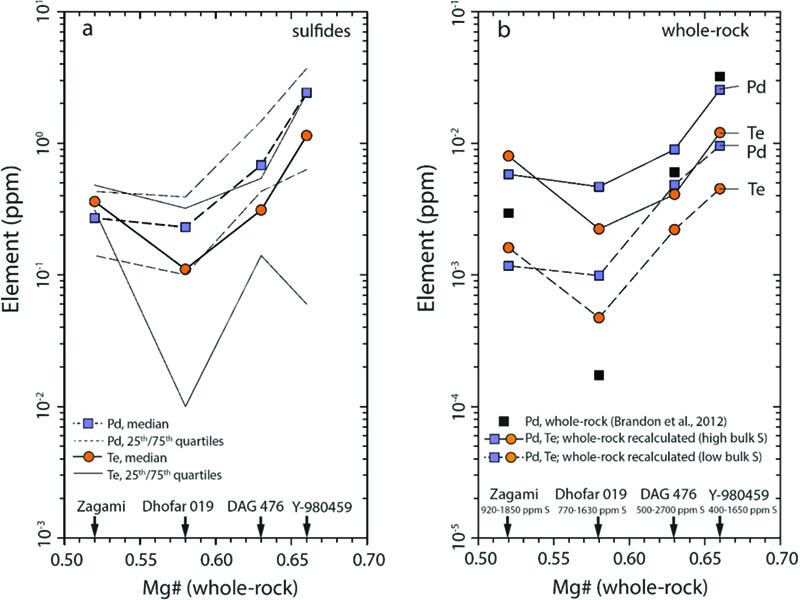
Figure 3. Concentrations of Te and Pd versus Mg# in the host rocks: a) sulfides, b) recalculated whole-rock concentrations. The latter are determined by Cwr=(Cs∙Swr)/Ss, in which Cs are the median and 25th/75th percentile concentrations in sulfides, Swr is the whole-rock content of sulfur, and Ss is the sulfur content in bulk sulfides assuming troilite stoichiometry (FeS). The lower and upper whole-rock sulfur contents used for calculation are those reported/surveyed in Ding et al. (Earth Planet. Sci. Lett., 2015). Whole-rock concentrations of Pd for the analysed shergottites are taken from Brandon et al. (Geochim. Cosmochim. Acta, 2012).
Use and misuse of ilmenite in diamond exploration
Ilmenite is a very common phase in kimberlites and related rocks and, as a consequence, is one of the main kimberlite indicator minerals (KIM) used to locate new targets. Because of its abundance in kimberlites, ilmenite has been investigated for diamond exploration, but its use as diamond indicator mineral (DIM) has been unsuccessful to date.
Complex crystallisation and replacement processes have been previously invoked to explain the compositional and textural variety of ilmenite found in kimberlites. The research presented here was carried out as a collaboration between CCFS, University of Barcelona and the Catoca mine (Angola) and it aims to shed new light on these processes, as well as their implications for diamond exploration. Petrographic studies were combined (for the first time) with major- and trace-element analyses to characterise the ilmenite populations found in xenoliths and as xenocrysts in two Angolan kimberlites (Congo-Kasai craton).
The study of mantle xenoliths already brought to light the complexity of the processes that can be involved in ilmenite formation at depth. In these xenoliths, ilmenite has a wide compositional range. It occurs either as thin veins or as small rounded grains, and may be accompanied by the crystallisation of a variety of metasomatic minerals (i.e. apatite, kaersutite, phlogopite and rutile).
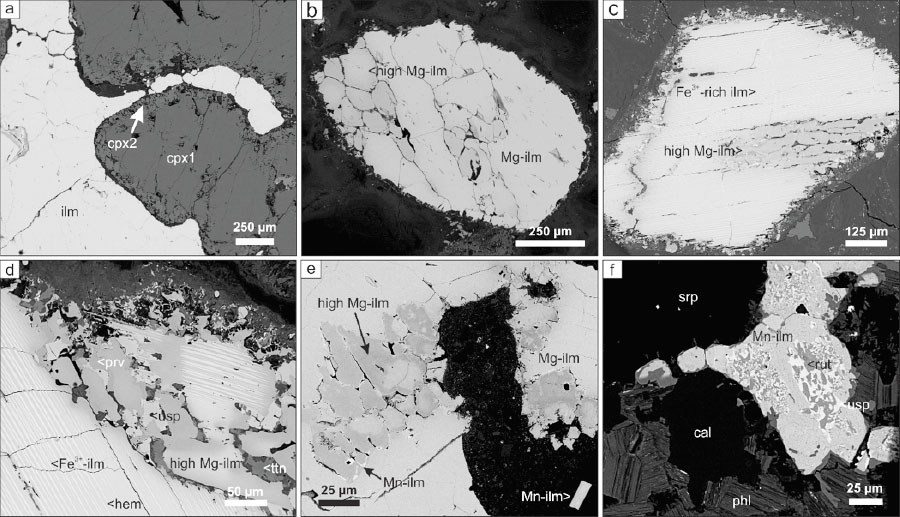
Figure 1. Textural types of ilmenite found in the Angolan kimberlites (BSE images). a) metasomatic ilmenite in a mantle xenolith, associated with a secondary clinopyroxene (cpx2) replacing an early clinopyroxene (cpx1) and olivine; b) ilmenite nodule showing recrystallisation and secondary enrichment in Mg set in the kimberlite matrix; c) Fe3+-ilmenite with fine hematite exsolutions replaced by symplectitic, darker Mg-rich ilmenite, which crystallises along fractures and grain boundaries. Detailed image (d) shows the complex replacement sequence of the symplectitic ilmenite: ulvöspinel (usp), perovskite (prv) and titanite (ttn); (e) nodular ilmenite replaced by Mg- and Mn-rich ilmenite along grain boundaries of the recrystallised grains, together with tabular Mn-rich ilmenite set in the kimberlite matrix; (f) late Mn-rich ilmenite, replacing previous rutile (rut) and ulvöspinel (usp), set in a matrix of serpentine (srp), calcite (cal) and phlogopite (phl).
However, ilmenite mainly occurs as individual xenocrysts in the kimberlitic matrix, where it can be found either as Mg-rich ilmenite nodules or as xenocrysts of ferrian ilmenite with hematite exsolution. Likewise, different types of secondary ilmenite were identified, in most cases replacing primary ilmenite grains and/or other titanium oxides: i) symplectitic ilmenite; ii) tabular ilmenite and iii) secondary Mn-rich ilmenite.
The trace-element analysis of ilmenite revealed that populations with the highest Mg contents (i.e. symplectitic, secondary Mg enrichment in the ilmenite nodules) typically show significantly higher contents of HFSE, Cr and V at a given Nb content, and thus diverge from the general trends described for most other ilmenites. These trace-element signatures in the ilmenite nodules, coupled with the co-crystallisation of perovskite, have been interpreted as a result of an interaction with the kimberlitic magma.
A multi-stage model has been proposed to describe the evolution of ilmenite in these pipes involving: i) Crystallisation of ilmenite under different conditions, both in crustal and metasomatised mantle domains; ii) Xenolith disaggregation producing at least two populations of ilmenite xenocrysts differing in composition (Fe3+- and Mg-ilmenite nodules); iii) Interaction of both types with the kimberlitic magma during eruption, leading to widespread replacement by Mg-rich ilmenite along grain boundaries and fractures. These processes produced similar major-element compositions in ilmenites regardless of their primary origin, although in most cases the original enrichment in HSFE (Zr, Hf, Ta, Nb) observed in Fe3+-rich crustal xenocrysts is preserved. Finally (iv) secondary Mn-ilmenite was formed by infiltration of late hydrothermal fluids, followed in some cases by subsolidus alteration in an oxidising environment.
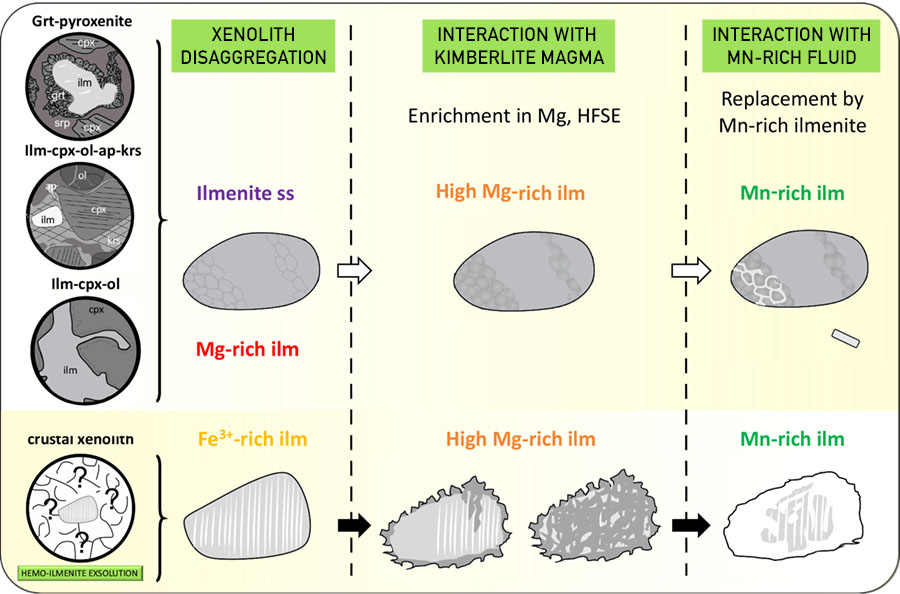
Figure 2. Schematic model of the multi-stage petrogenesis of ilmenite in the studied kimberlites, including the average composition of ilmenite at each stage. Mineral abbreviations: clinopyroxene(cpx), ilmenite (ilm), garnet (grt), serpentine (srp), apatite (ap), kaersutite (krs) and olivine (ol).
This study has shown that ilmenite genesis is complex and may lead to misinterpretation of the diamond potential of a kimberlite during the exploration stage if textural and trace-element information is disregarded. Secondary Mg-enrichment of ilmenite xenocrysts is common and is unrelated to reducing conditions that could favour diamond formation/preservation in the mantle. Similarly,
Mn-rich ilmenite should be disregarded as a diamond indicator mineral, unless textural studies can prove its primary origin.

This project is part of CCFS Themes 2 and 3, Earth’s Evolution and Earth Today, and contributes to understanding Fluid Fluxes.
Contacts: Montgarri Castillo-Oliver, Bill Griffin, Norman Pearson, Sue O’Reilly
Funded by: CCFS Flagship Program 1
Cerium in zircon - serial tracking of mantle controls
Magmas emplaced deep in the Earth’s crust cool slowly, and precipitate a sequence of mineral assemblages on the floor and walls of magma chambers. This crystallisation produces residual liquids that are depleted in many elements and enriched in others, relative to the parental silicate melt. In many cases, whether an element is sequestered in early minerals or accumulates in residual melts depends on the oxidation state of the melt, which enhances or hinders the ability of any given magma to produce ore deposits of many elements.
Oxidation/reduction couples that commonly are of petrologic and economic interest include Fe3+/Fe2+, S6+/S4+/S2-, Eu3+/Eu2+, Ce4+/ Ce3+, U6+/U5+/U4+, Mo6+/Mo4+, Sn4+/Sn2+, V5+/V4+/V3+, Ti4+/Ti3+, As5+/As3+, Se6+/Se2- and Mn3+/Mn2+.
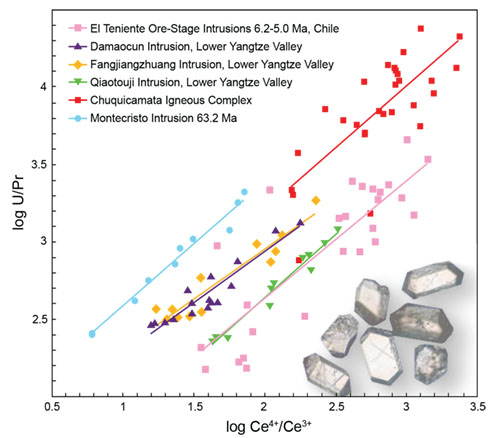
Figure 1. Zircon Ce4+/Ce3+ values reported by authors of the source publications are plotted against the U/Pr ratios in those zircons. The zircon/ melt partition coefficients of Ce and U respond oppositely to varying magmatic oxidation state, so these strong positive correlations prove that there is no resolvable component of the variation in zircon Ce4+/Ce3+ that can be attributed to varying magmatic oxidation state.
Determination of the former oxidation state of a magma by chemical analysis of minerals in igneous intrusions is often hampered by subsolidus re-equilibration and/or alteration. The most sensitive and best-calibrated of the igneous mineral oxybarometers currently in use by petrologists - titanomagnetite-hemoilmenite pairs and chromite-bearing assemblages - re-equilibrate within days to weeks at near-solidus temperatures, and are reliable only when used on quickly-quenched volcanic rocks. A problem affects igneous amphibole oxybarometry and hygrometry; as magmas rise to depths <4-5 km, exsolution of H2O from the silicate melt causes breakdown of amphibole to anhydrous minerals on timescales of days to weeks, and magmatic hornblende is not stable at shallower depths. Consequently, we need other equilibria to constrain ƒO2. The potential appeal of a zircon oxybarometer is that chemical diffusion (re-equilibration) in zircon is extremely slow and zircon compositions are unaffected at granitoid magma temperatures at timescales on the order of 105-106 years.
The Ce4+/Ce3+ ratio in zircon and the closely related Ce anomaly, which is commonly denoted Ce/Ce*, are widely used as proxies for the oxidation state of the zircon’s parent silicate melt. The ratio U4+/Pr3+ involves nearly the same ion sizes as Ce4+/Ce3+ in zircon, so the two have similar temperature sensitivity, but opposite responses to redox variation in the parent melt. Plots of these ratio pairs in natural igneous zircon populations show strong positive correlations with slopes near unity, which invalidates their use as magmatic redox indicators (Fig. 1). We conclude that the Ce4+/Ce3+ and Ce/Ce* ratios in zircon that are commonly referred to as oxybarometers actually vary in and among zircons chiefly in response to variations in the temperature at which zircon crystallised. Presently available zircon geothermometers are too imprecise to distinguish the small redox effect from the dominant temperature effect in most natural assemblages.

This project is part of CCFS Theme 3, Earth Today, and contributes to understanding Fluid Fluxes.
Contacts: Robert Loucks, Marco Fiorentini, Bruce Rohrlach (Avalon Minerals Ltd)
Funded by: CCFS Flagship Program 2

 ARC Centre of Excellence for Core to Crust Fluid Systems
ARC Centre of Excellence for Core to Crust Fluid Systems